THE SWEET SPOT
On board Custom Line's new 38-metre
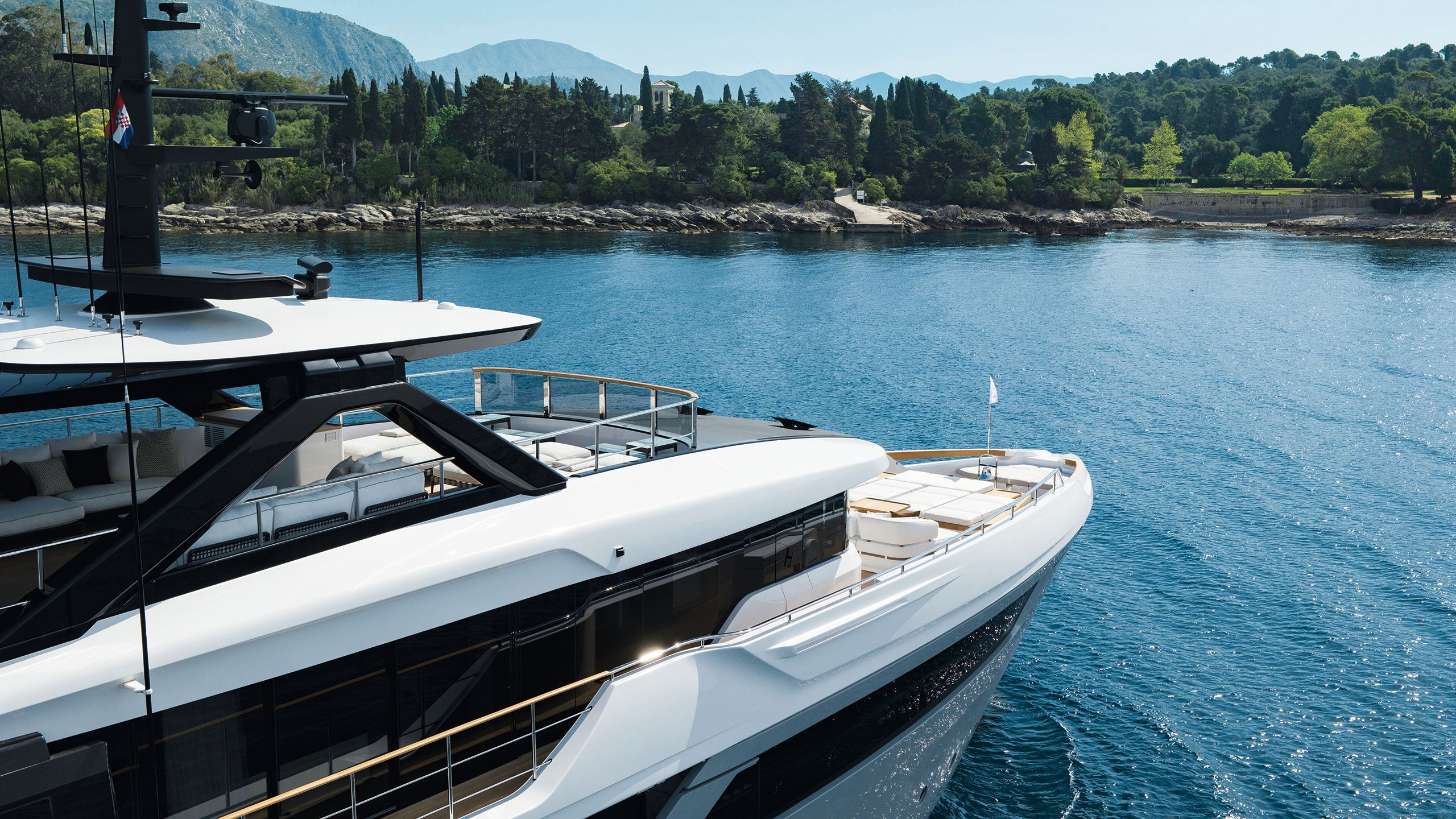
The new Custom Line 38 reinvents a successful model with more space, laid-back style and a spritz of Italian polish. Caroline White discovers how it was honed to clean up in the mid-size market
CUSTOM LINE YACHTS
When you run a yacht-building group of seven superlative brands, how do you identify a strategically significant product? For Ferretti Group CEO Alberto Galassi, is that crucial new launch a glamorous Riva runabout likely to attract new clients who will go on to want a larger boat, or is it a CRN superyacht likely to generate big profits (and plenty of headlines)?
His view may surprise you. He points to a reinvention of the Custom Line Navetta 37, a line of displacement yachts that has quietly but steadily attracted clients to the Ferretti Group with 15 sold in seven years.
“The 38 is in the middle of the range; it is going to inspire the smaller sister and the bigger sister,” he says. “So if you get the 38 right, you know that the product range in the next four or five years is going to be very strong. If you get the 38 wrong, well…”
You really don’t want to get it wrong. The first hull, Telli, is owned by the Ferretti Group but is in effect Galassi’s yacht, and his experience, choices and influence are evident throughout the design. So as a Ferretti Group employee, you really, really don’t want to get it wrong.
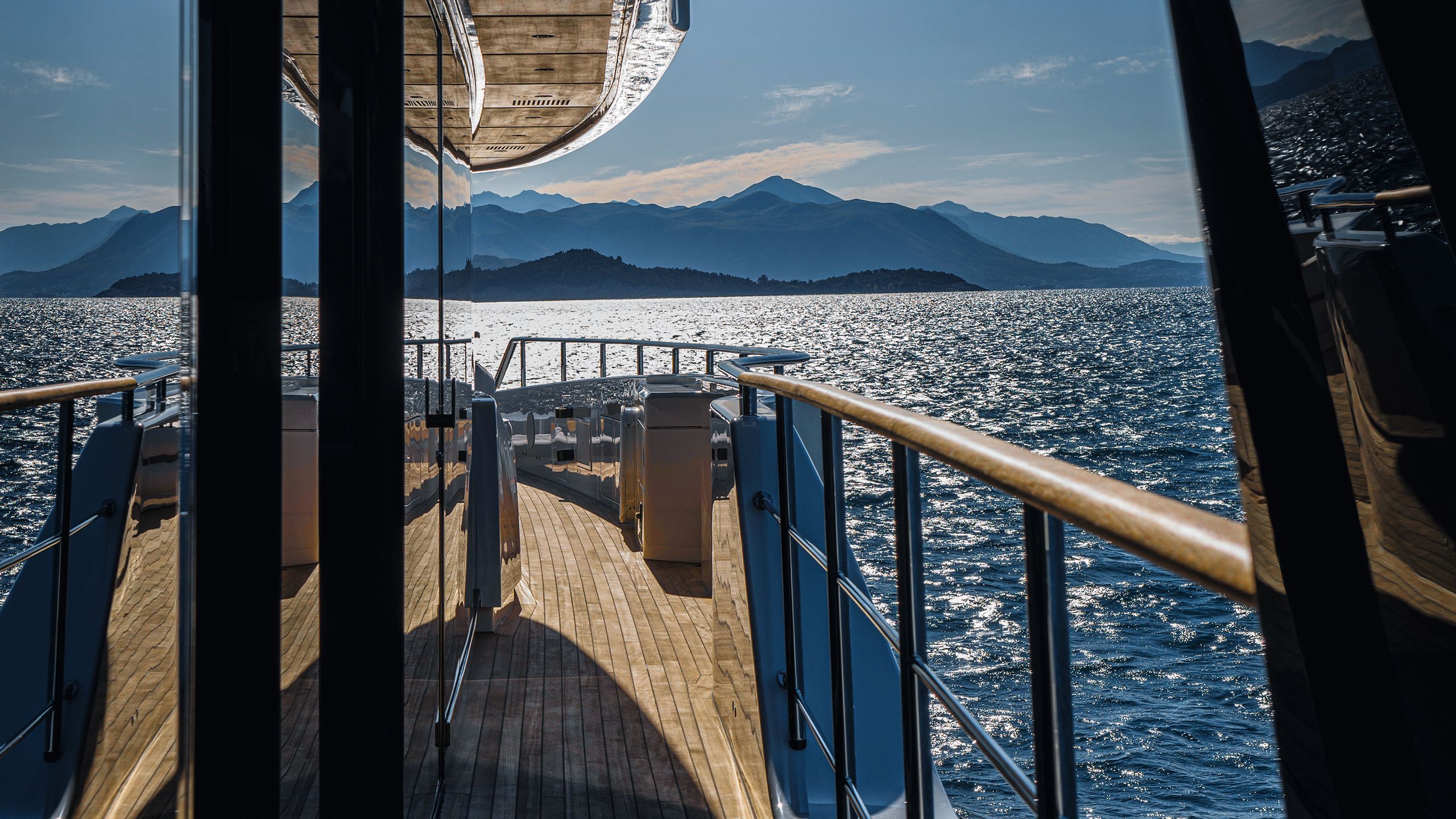
CUSTOM LINE YACHTS
CUSTOM LINE YACHTS
The impetus for the 38 was mundane: the IMO has designated the entire Mediterranean as a sulphur Emission Control Area from 2025. This means that most new superyachts will need a selective catalytic reduction system to comply – which requires a lot more engine-room space.
Rather than fiddling with the 37’s layout, Custom Line decided to update the whole design, incorporating stylistic updates, the group’s big boat technical knowledge, as well as feedback from Navetta 37 owners. Upon this foundation, it wanted to build a light, calming interior with a stylish exterior that was recognisably part of the Custom Line family.
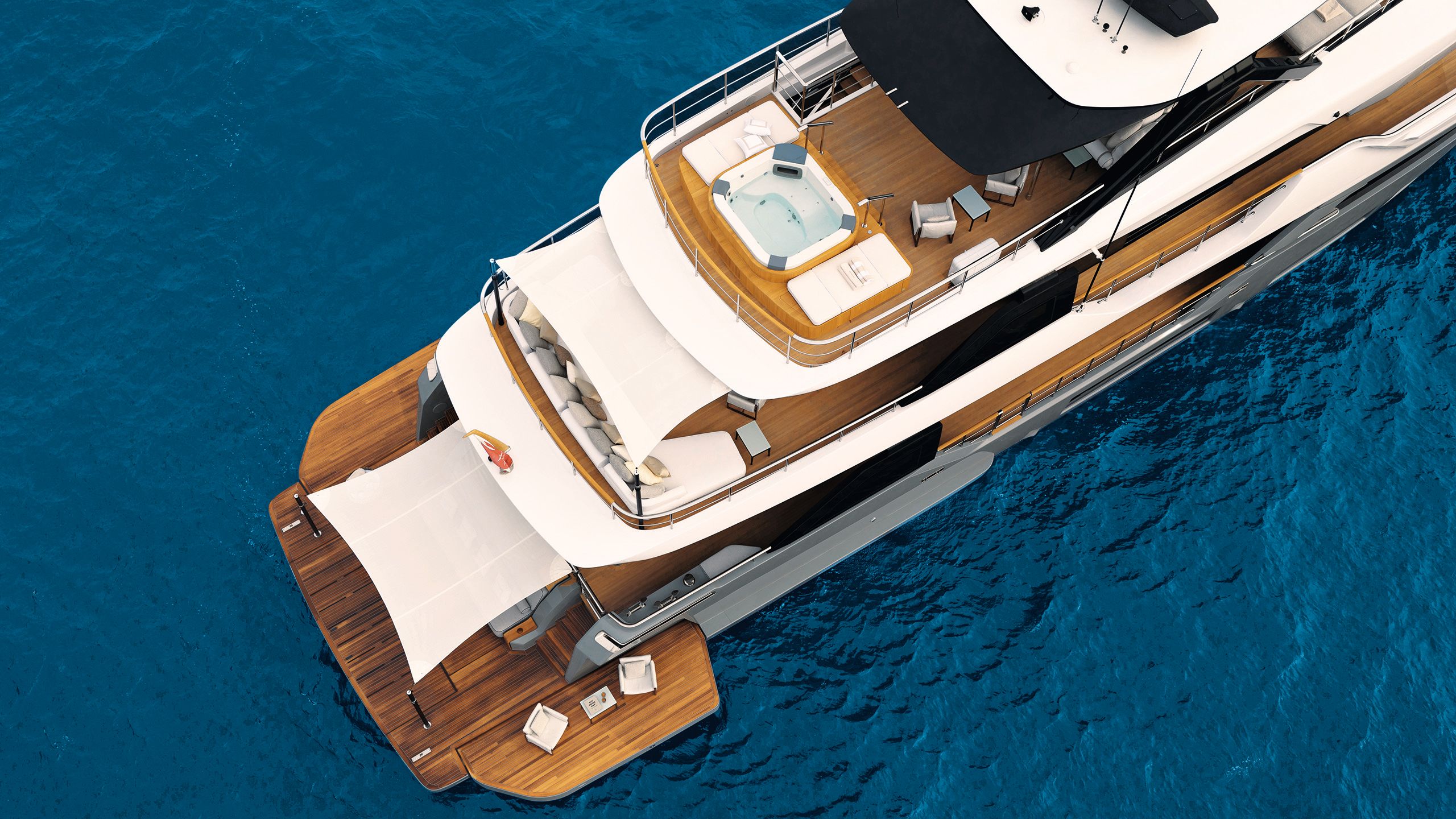
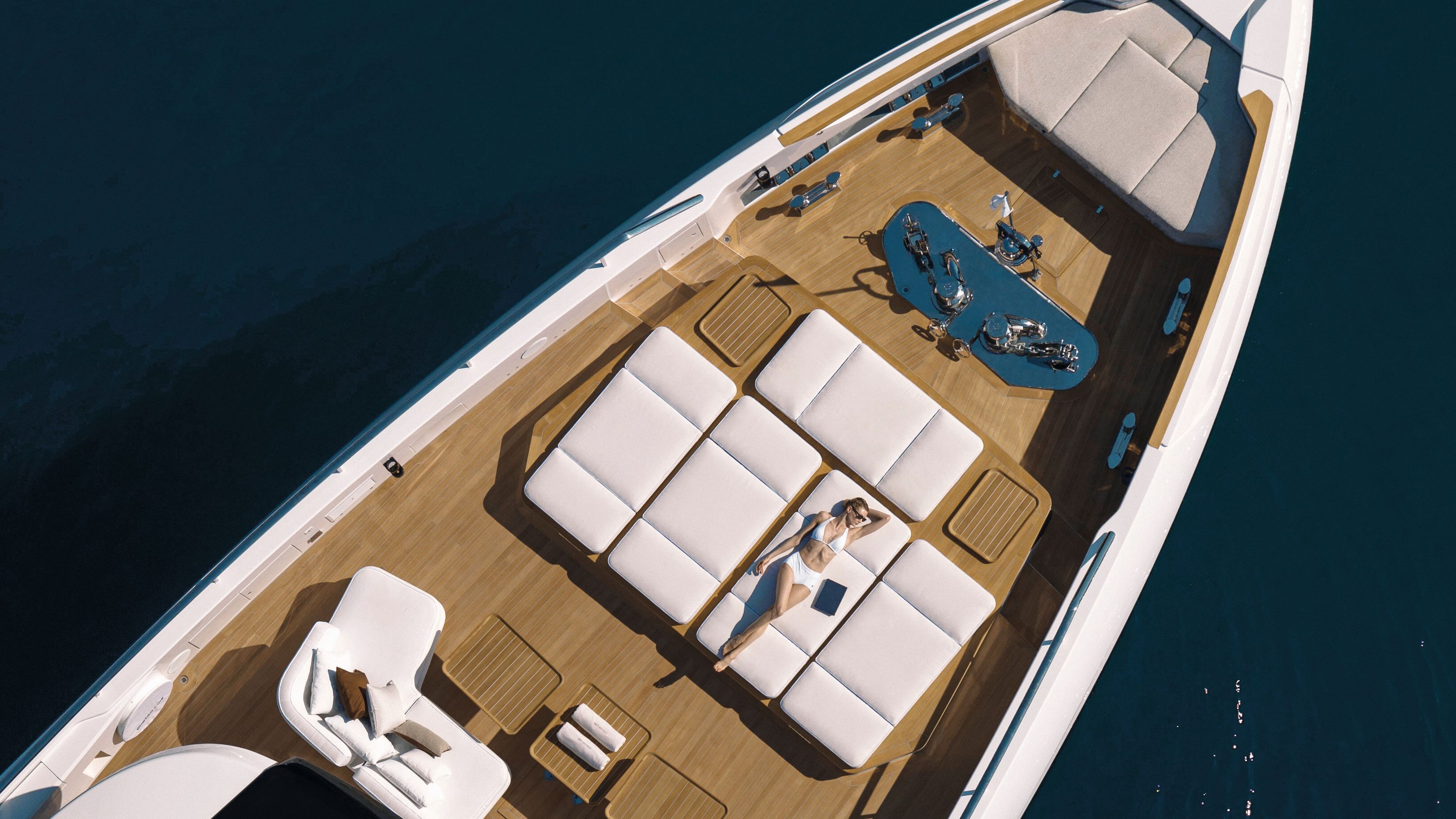
The Navetta 38 shows a contemporary take on Custom Line’s simple, elegant ethos
The man tasked with this was Filippo Salvetti. The naval architect’s collaboration with Custom Line in 2019 signalled the beginning of a project to refresh the whole Navetta line, and aside from the 38 he’s worked on exteriors for the 30 and the recently launched 50.
He says family traits of the line are, “harmonious proportions, balance and refinement”, with “shapes and lines that evoke a sense of continuity and permanence, inspired by the classical principles of simplicity and purity”.
Details should be complementary, discreet and unobtrusive. While adhering to the same principles of simplicity and elegance, the 38 updates the 37’s exterior with a more contemporary look.
“Its surfaces move with fluidity, creating a surface tension that imbues the vessel with a sporty yet elegant character,” he says. The pale grey hull, whose tone appears to shift with changing light, is contrasted with black and white elements higher up.
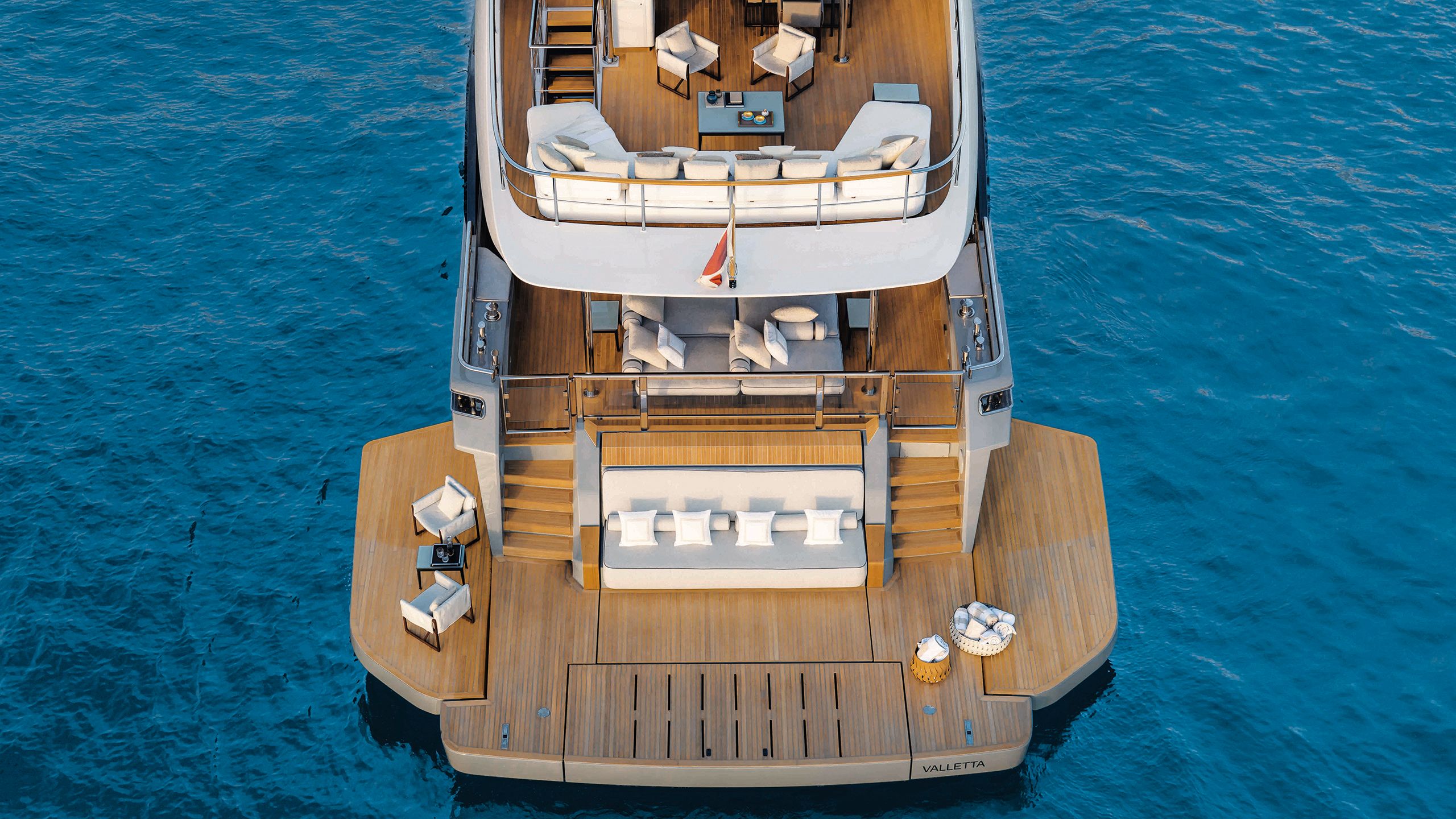
CUSTOM LINE YACHTSThe sofa on the swim platform folds up to reveal the tender garage
CUSTOM LINE YACHTSThe sofa on the swim platform folds up to reveal the tender garage
For the interior, the yard brought in the architectural and interior design studio ACPV Architects, whose founders Antonio Citterio and Patricia Viel also worked on the Navetta 30 and the Custom Line 50. Their hallmark style is contemporary, calming and effortlessly cool, with a focus on well-being.
“At first it was challenging for us to understand how we could design for the series – [since] the specific quality of this product was to be customised,” Viel says. The explanation, she says, has to do with the Ferretti Group’s comprehensive range of brands, which she describes as “touching everything you can imagine that is floating and of a certain quality”.
To make that panoply work, “they maintain a very, very strong identity for each brand – and the identity of Custom Line is very much recognisable.” That helped define the framework.
Taking the 38 specifically, the studio defined design features and details that are not subject to customisation and allow for an owner’s personal taste or style to be expressed through furniture and fittings.
One such design motif is a nautical curve found throughout the boat: “We always try to express the shape of the hull because we want our owners to keep in mind that they are not in an apartment on Central Park,” says Viel.
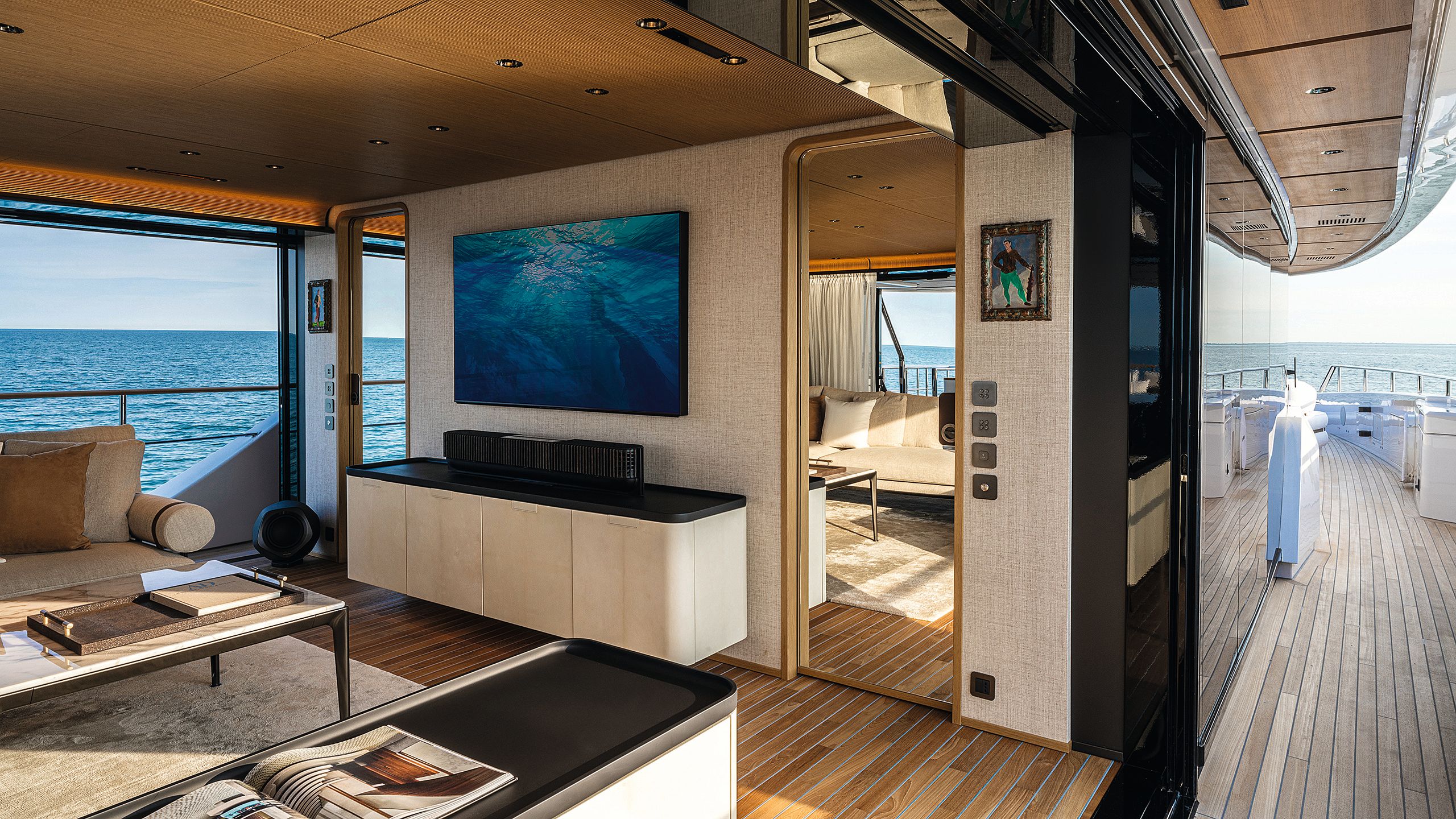
CUSTOM LINE YACHTS
CUSTOM LINE YACHTS
“I don’t like to be closed in, and the upper deck with sliding doors, which becomes a huge terrace on three sides – that’s the best feature of the boat”
“I don’t like to be closed in, and the upper deck with sliding doors, which becomes a huge terrace on three sides – that’s the best feature of the boat”
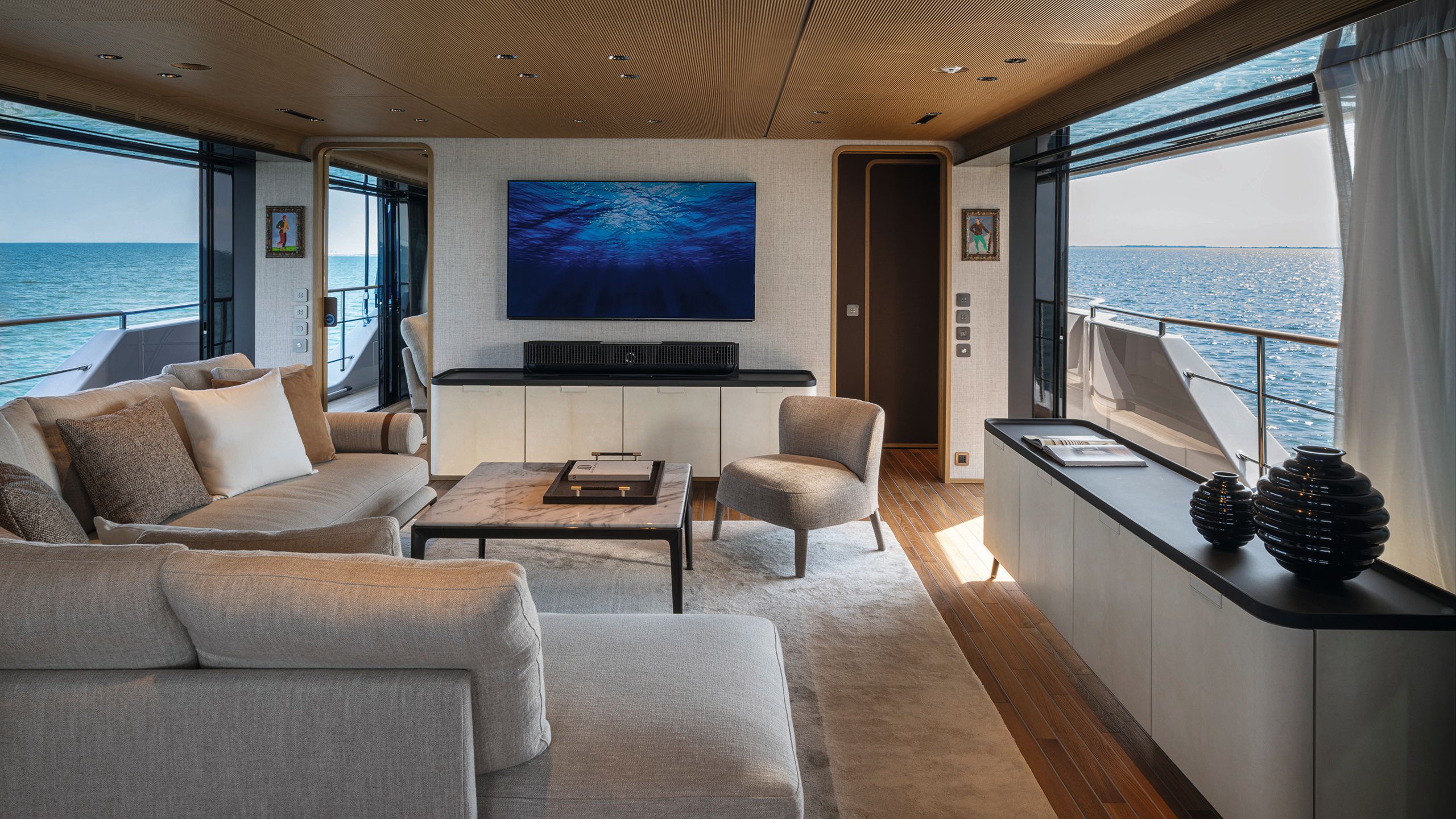
The door frames are rounded, as on traditional ships, but so are walls, which often appear to melt into floors or ceilings as they curve.
Since ACPV Architects fully designed the interior of this first model, the approach extends to loose furniture and other decor. What makes it so pleasing to the eye, if even semi-consciously, is consistency (the curve has the same radius throughout the boat).
Another key ingredient to the atmosphere on board is natural light. The lower deck guest cabins feature substantial ports – “I can assure you that it is not so simple to approve this kind of window,” says Giordano Pellacani, sales and marketing director of custom business at Ferretti Group, hinting at the technical glasswork required to capture this amount of sunlight below deck.
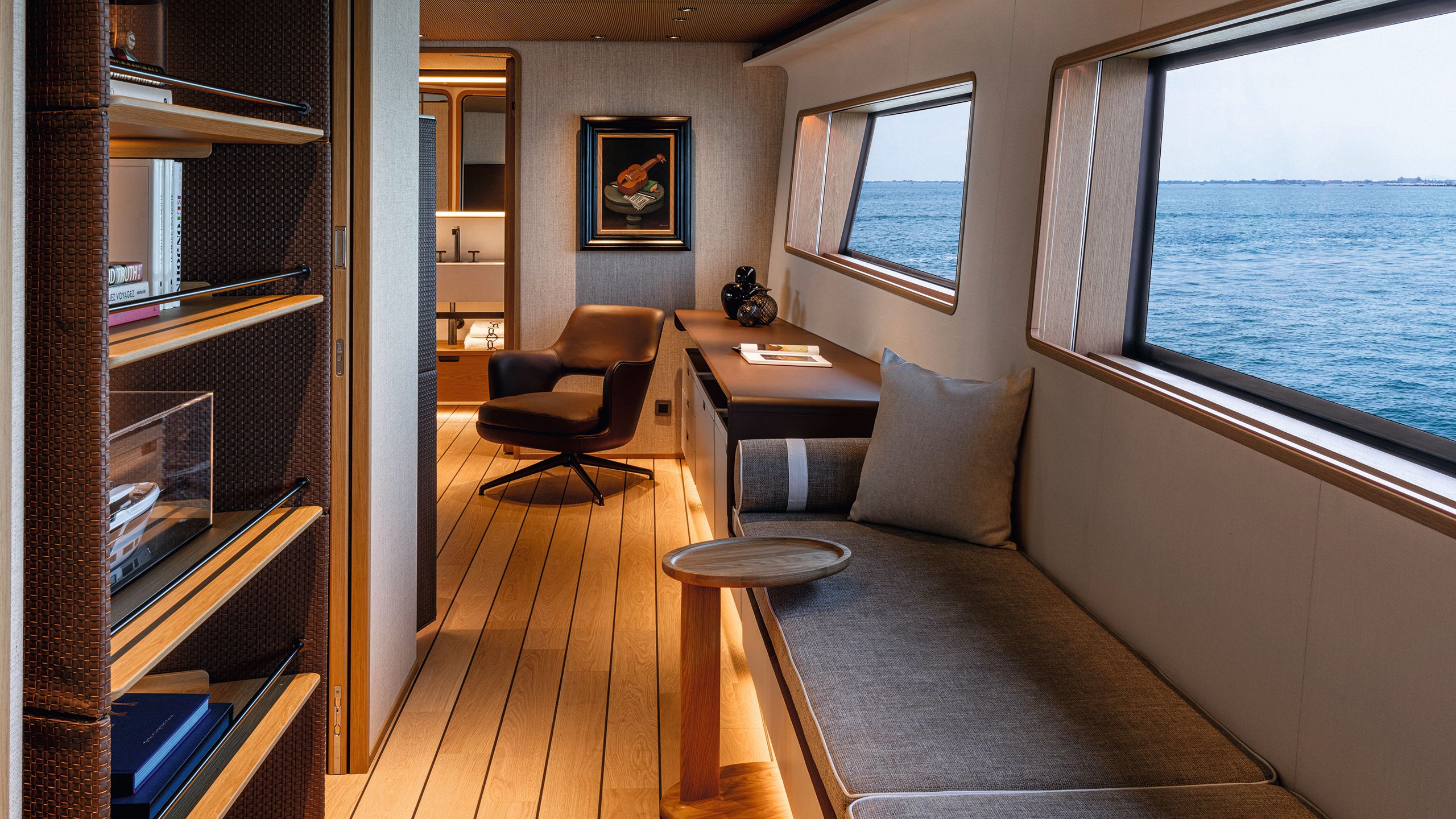
CUSTOM LINE YACHTS
CUSTOM LINE YACHTS
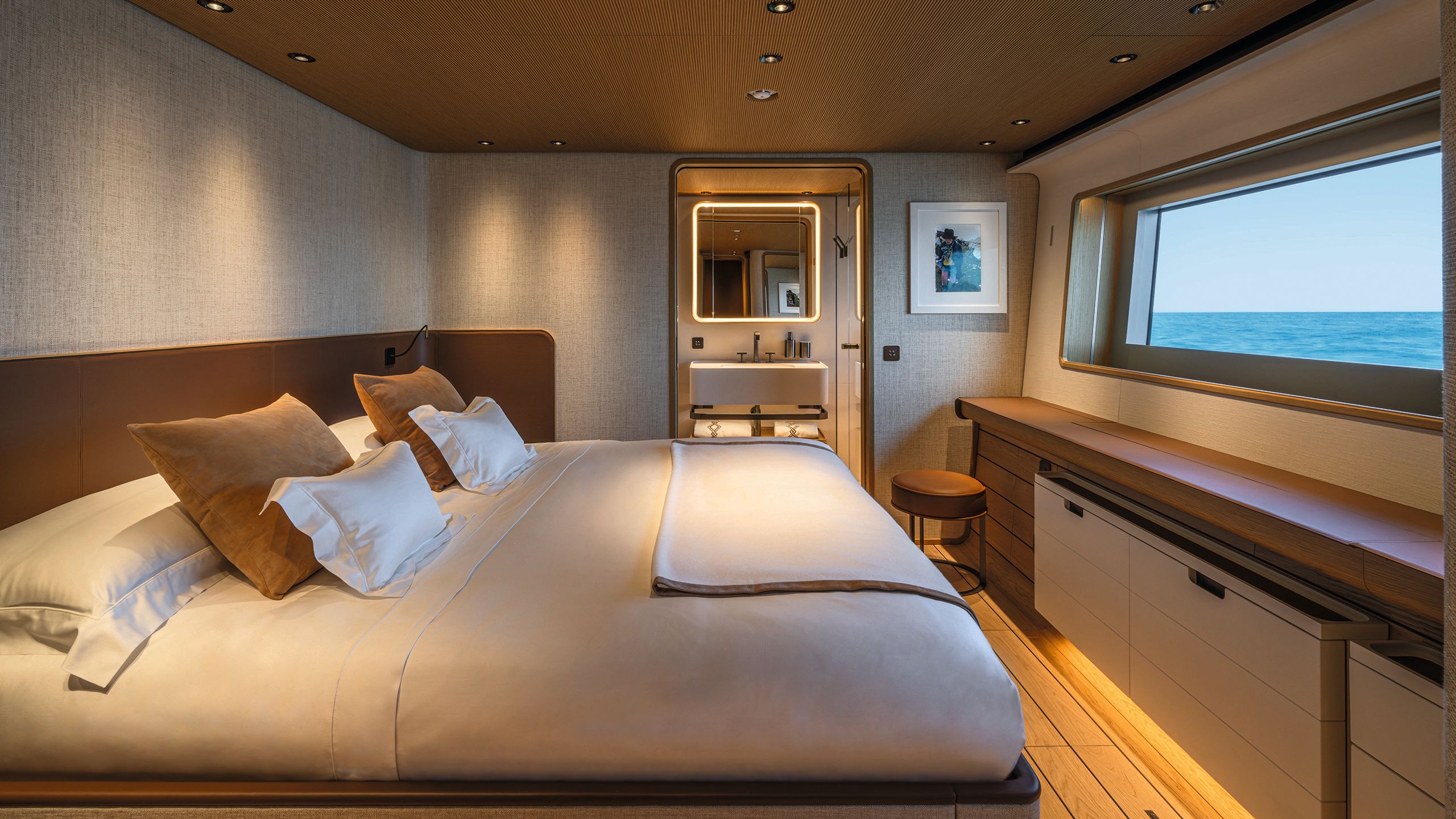
CUSTOM LINE YACHTS
CUSTOM LINE YACHTS
In the owner’s suite, a desk and window seat take advantage of the views (left); the VIP cabins enjoy plenty of light from large windows (right)
An open-plan bathroom/bedroom arrangement in the aft cabins also gives the impression of more space. Down here, instead of taking space from the guest cabin area to enlarge the engine room, the new design has gleaned the additional centimetres mainly by taking better advantage of the full beam.
“When surfaces and materials play with light they express their character through texture”
The owner’s cabin lies forward on the main deck and here the beam is really visible, not least because the space has been pushed right out to follow the natural curve of the hull.
Following the Navetta 37 owners’ feedback, a walk-in wardrobe has been added. The full-width en suite lies forward, while long seats by the window again show where your gaze should really be fixed.
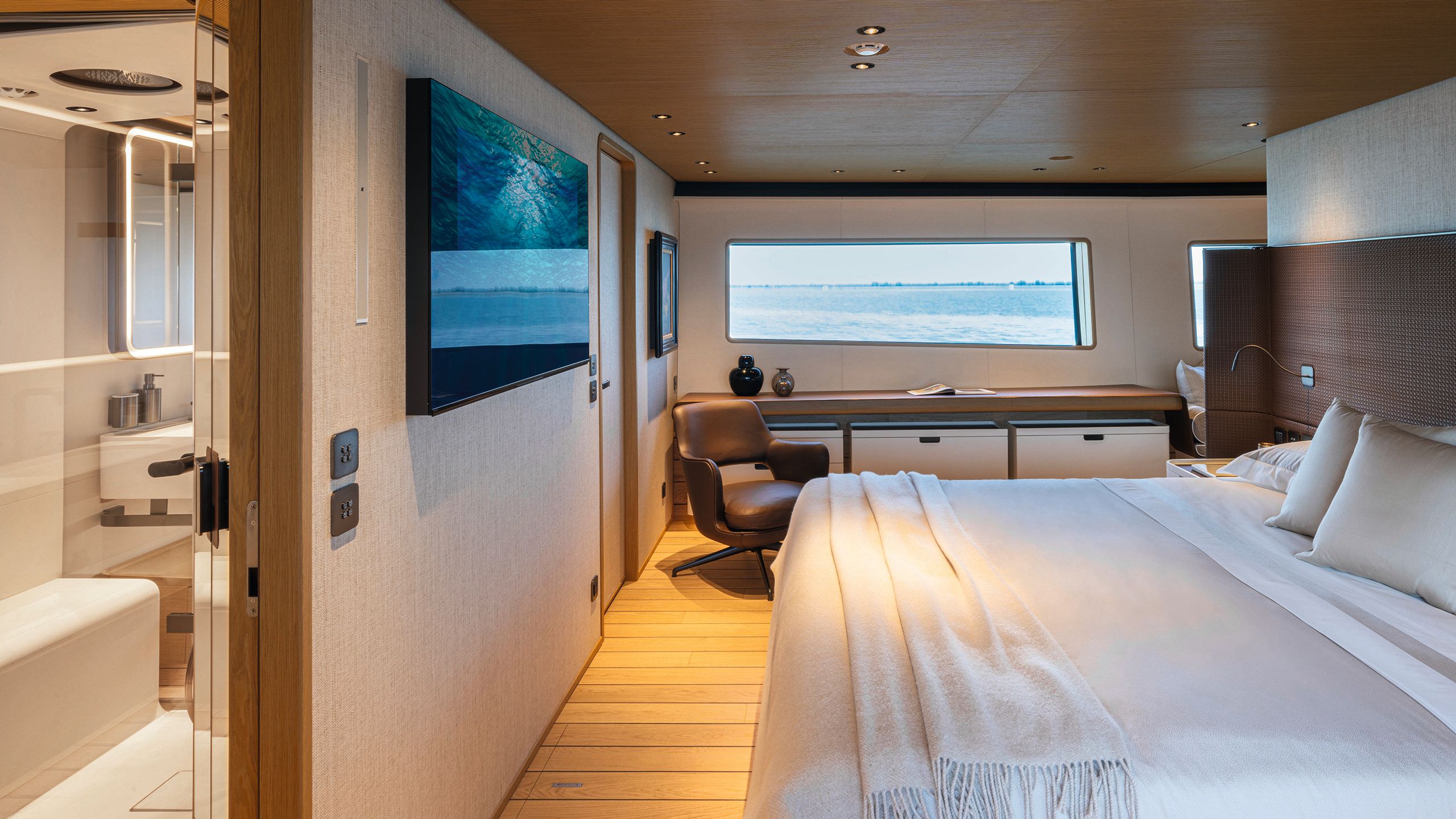
On the main and upper decks, the yard went to town with glass. Windows are full height, with metal frames added to the fibreglass and carbon-fibre superstructure on the main deck to allow for even greater apertures. Custom Line also cut the corresponding bulwarks right down to the deck on both levels, for maximum views from inside.
The effect is emphasised by ACPV Architects’ reflective window surrounds “but not just reflecting light with mirrors, which is in our view disturbing perception of the space”, says Viel. “They are treated with black glass or dark grey mirror. So there is a sense of being inside, but you don’t lose the quality of the natural light.”
GIVE AND TAKE
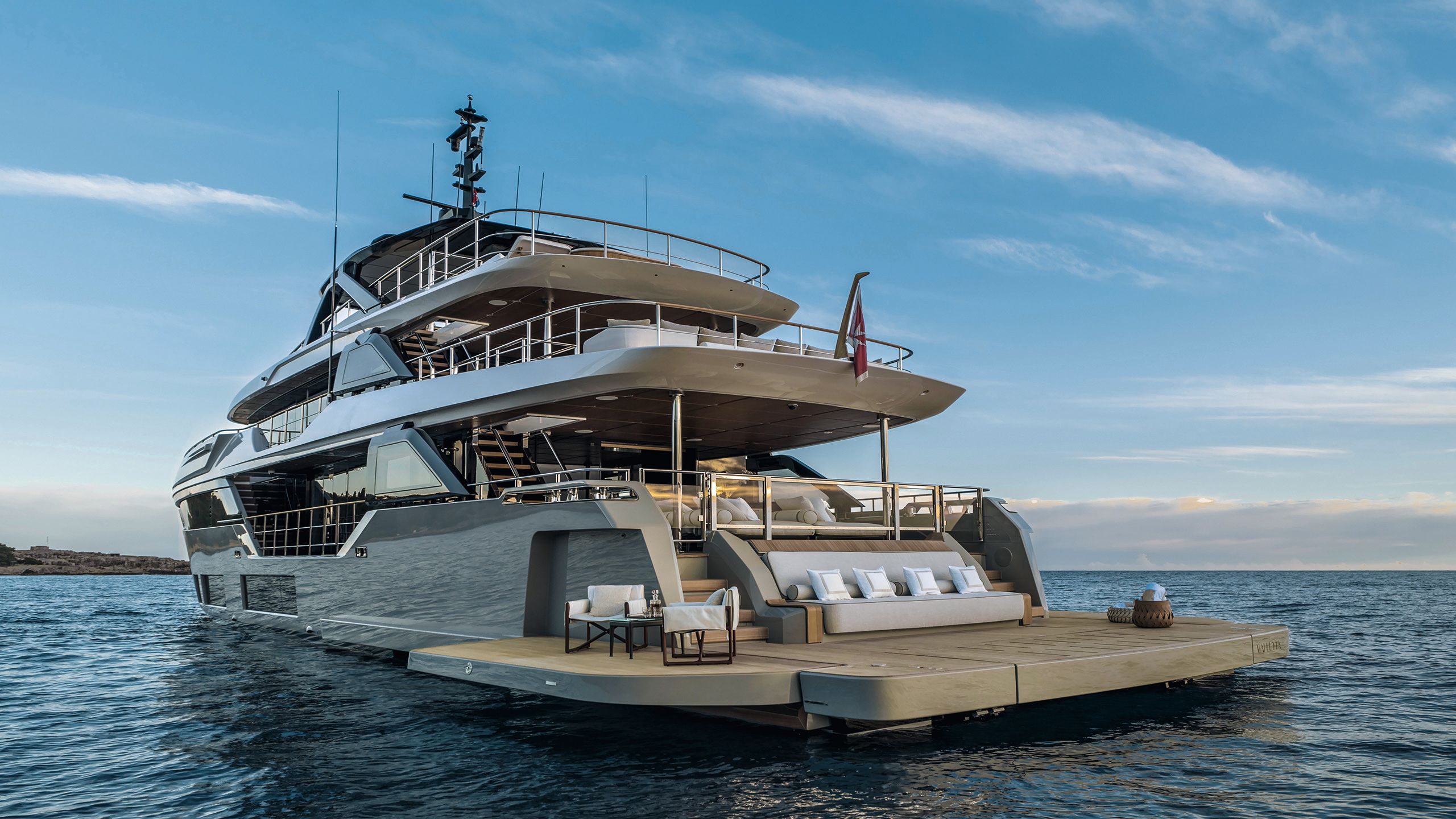
Space is a luxury that yacht designers famously don’t have. Working within the confines of a limited envelope is a real skill, and the less space is available, the more expertise is required to give the impression of it. For Patricia Viel, whose architectural work spans penthouses, boutiques, towering office blocks, lavish hotels and even a plaza in the middle of New York City, the special challenges of yacht projects are a refreshing foil.
She is a passionate sailor and describes the peculiarities of yacht design – a more intimate process, where you have to take into account both sophisticated technical issues and the structure’s vital relationship with wind and water – as more “vacation” than work.
It is, she says, an architect’s “work to look after space and deliver it to the client”. To that end, you “find extremely adjusted solutions for ancillary spaces”, and essentially, fight for every inch. But, crucially, once you’ve won space by implementing extreme efficiency in places where it can’t be seen, you have to give it away with generosity in places where it can.
“You want your dining table on your cockpit to give you a sense of abundance,” she says. In this way, the furniture on Telli comprises full sized residential pieces by Antonio Citterio. The effect is an atmosphere of bounty and comfort – and all the work that created it is invisible.
Space is a luxury that yacht designers famously don’t have. Working within the confines of a limited envelope is a real skill, and the less space is available, the more expertise is required to give the impression of it.
For Patricia Viel, whose architectural work spans penthouses, boutiques, towering office blocks, lavish hotels and even a plaza in the middle of New York City, the special challenges of yacht projects are a refreshing foil.
She is a passionate sailor and describes the peculiarities of yacht design – a more intimate process, where you have to take into account both sophisticated technical issues and the structure’s vital relationship with wind and water – as more “vacation” than work.
It is, she says, an architect’s “work to look after space and deliver it to the client”. To that end, you “find extremely adjusted solutions for ancillary spaces”, and essentially, fight for every inch.
But, crucially, once you’ve won space by implementing extreme efficiency in places where it can’t be seen, you have to give it away with generosity in places where it can.
“You want your dining table on your cockpit to give you a sense of abundance,” she says. In this way, the furniture on Telli comprises full sized residential pieces by Antonio Citterio. The effect is an atmosphere of bounty and comfort – and all the work that created it is invisible.
The main saloon combines the practical and aesthetic. Almost every surface contains hidden storage for glassware and crockery: “If you want to do a proper service you need to have at least three sets,” says Pellacani. But the front of the cabinetry acts as a gallery space, for an owner to hang his own art. (Telli’s walls showcase a treasure trove of works by Andy Warhol, Fernando Botero, Mimmo Paladino and Salvo.)
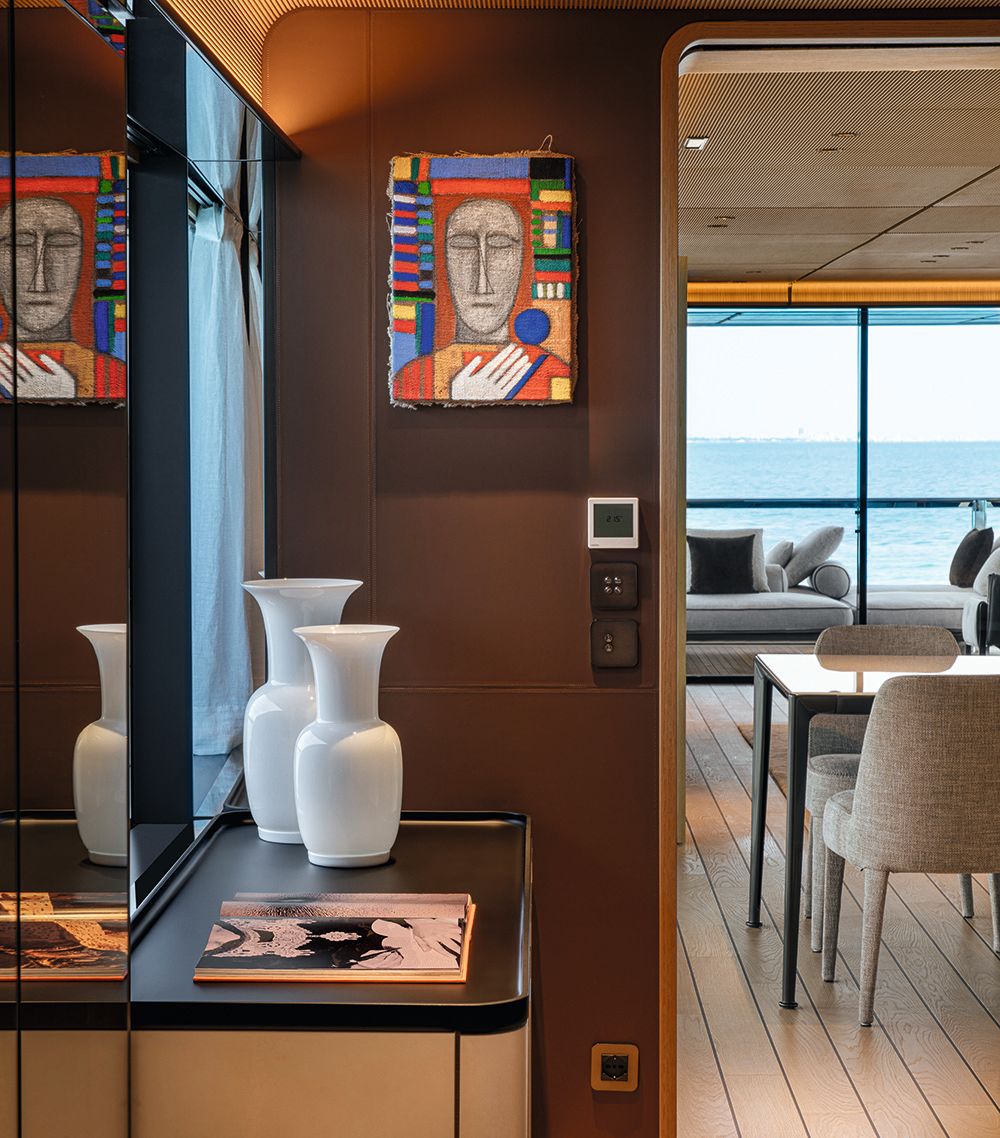
CUSTOM LINE YACHTSThe main saloon is a gallery of artworks and is furnished with fullsized residential pieces by Antonio Citterio
CUSTOM LINE YACHTSThe main saloon is a gallery of artworks and is furnished with fullsized residential pieces by Antonio Citterio
The upper deck is Galassi’s favourite space on board. “I’m not an air conditioning guy,” he says. “I don’t like to be closed in, I like the al fresco style with open air, and the upper deck with sliding doors, which becomes a huge terrace on three sides – that’s the best feature of the boat.”
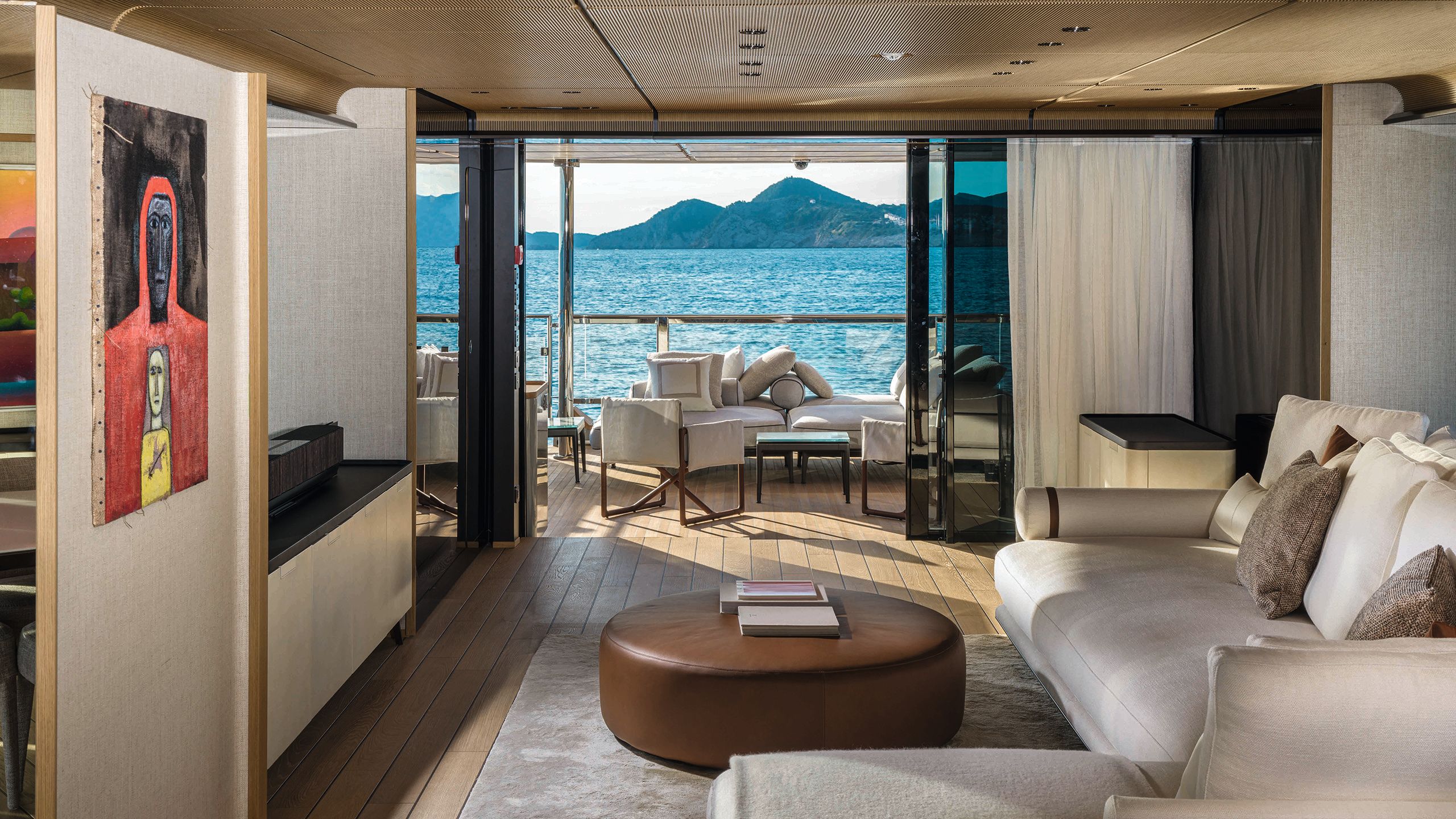
CUSTOM LINE YACHTS
CUSTOM LINE YACHTS
To complement the light spaces and curves, ACPV Architects introduced a natural decor with a chic but laid-back feeling. This translates to raffia wall coverings, tan stitched Foglizzo leather, brushed black chrome and neutral oversized furniture by Antonio Citterio.
“We always try to be soft, matt and neutral in colour but giving a little tactility: treating surfaces with [cross] hatches, or carved details,” says Viel. “When surfaces and materials play with natural light, they express their character through texture.”
As Galassi puts it, “You can feel the luxury of the materials that we use. From the wood finish and the leather, to the floor which is made in a very special way, to the crema d’Orcia limestone that was the stone that Michelangelo used.”
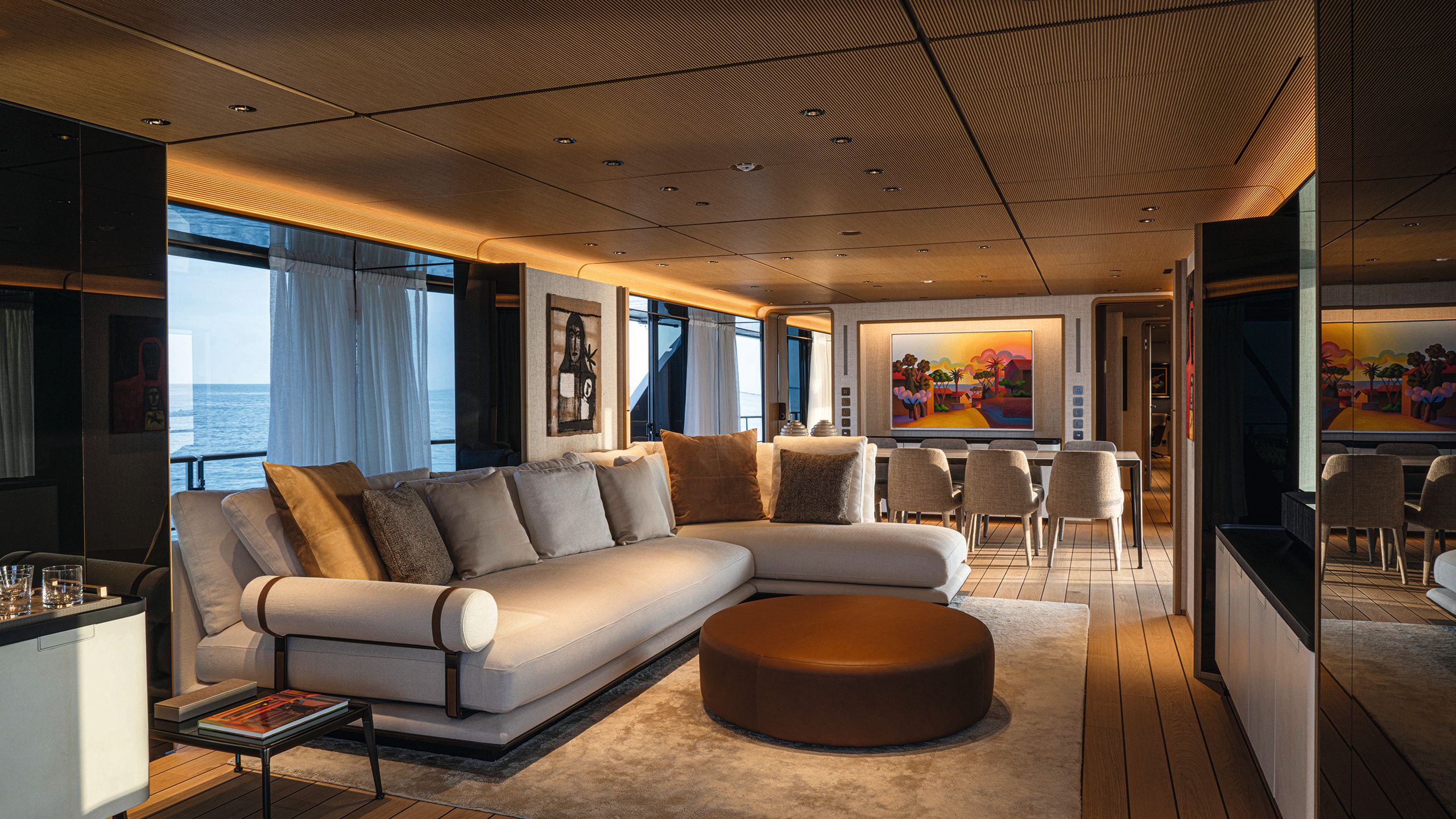
CUSTOM LINE YACHTSThe carefully considered interior lighting plan throughout the yacht took months to conceive
CUSTOM LINE YACHTSThe carefully considered interior lighting plan throughout the yacht took months to conceive
This warm, cream-coloured stone is used in bathrooms, rather than marble. “It comes from the west of Italy,” says Pier Francesco Boschi, project manager at Custom Line.
“It’s sanded and then we add primers to close the pores [to water].” More than anything, the scheme showcases natural oak, in floors, framing for doors and cabinetry and the main deck ceiling, where it is finely ribbed.
“That has a double effect, because it has very high acoustic performance (noise damping) and visually you really perceive a wood surface with depth.” That means that the already good head height of just over two metres seems even taller – implying a luxurious generosity of space.
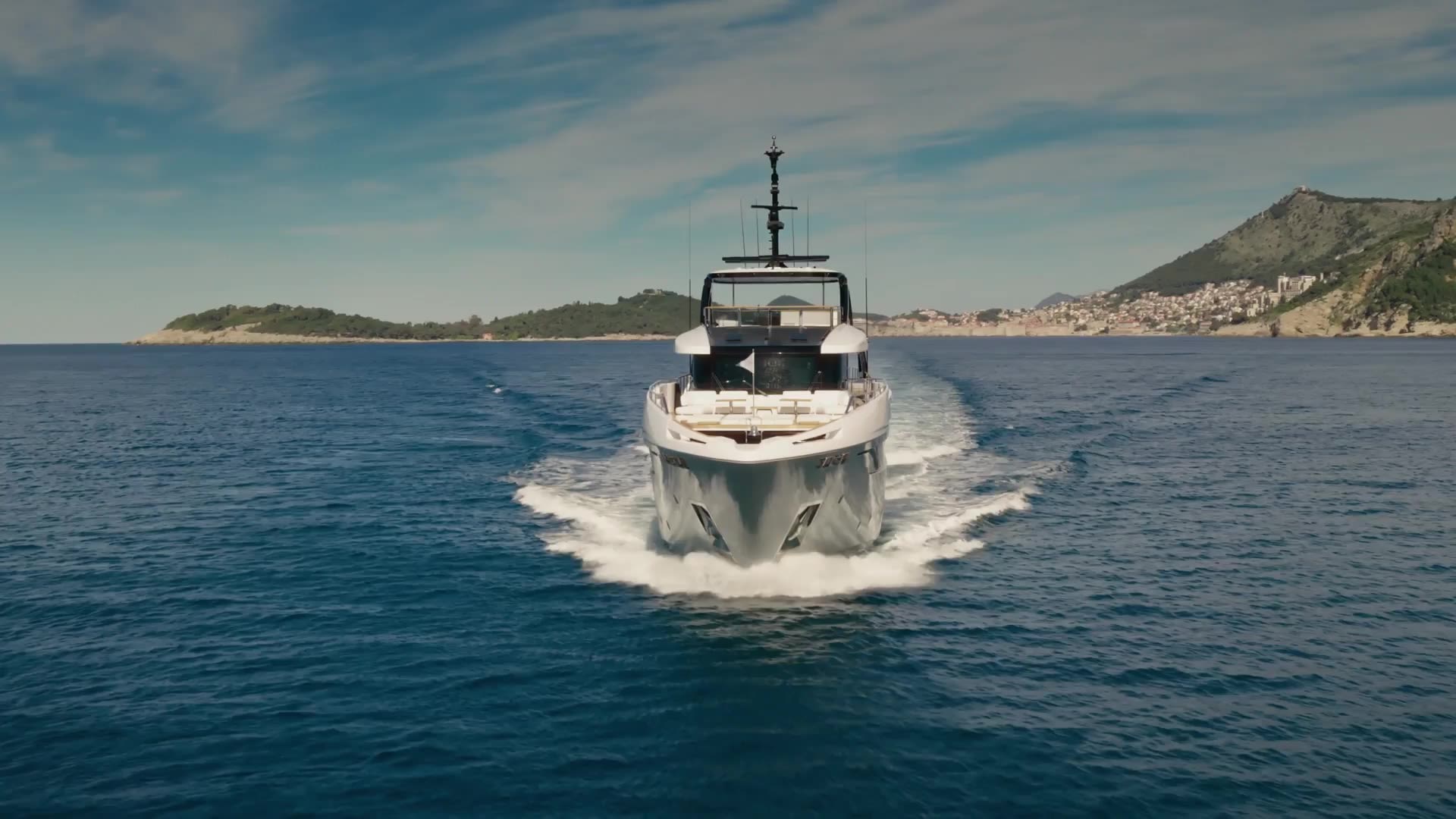
That generosity extends outside too, where square metreage has been expanded or optimised. The foredeck (which opens to house a jet ski or secondary tender) offers lots of space in two distinct seating areas, plus an extra nook in the nose of the bow.
Furniture appears built-in but in fact is merely secured to the deck with removable screws, making this a flexible space. Up top, Pellacani says the 70-square metre sundeck is 20 per cent larger than the 37 and more comparable to that of the Navetta 42. It features a Jacuzzi-brand hydromassage spa pool, its surround a stylish custom-made fibreglass dais with sunpads, a bar (under the radar arch) and forward, sun loungers.
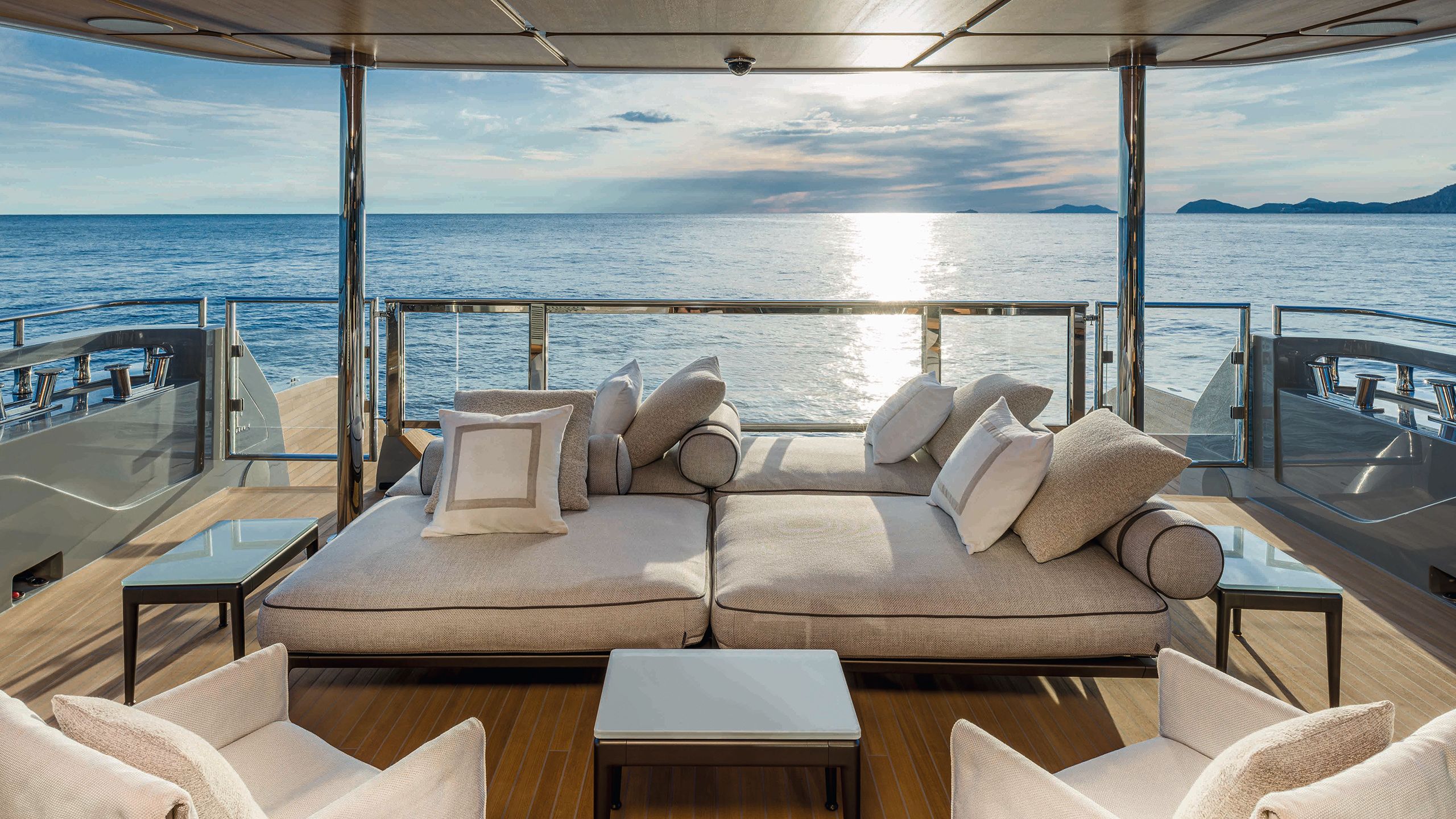
CUSTOM LINE YACHTSThe aft deck’s loose modular furniture makes the space feel bigger
CUSTOM LINE YACHTSThe aft deck’s loose modular furniture makes the space feel bigger
But perhaps the most significant change is the revamped swim platform – the 37’s closed transom that folded open is parlayed into a permanent and much larger platform (this is where much of the 38’s extra length has gone), enhanced by two supplementary fold-out wings on either side.
To launch the tender, housed in a garage just forward, the swim platform descends, the attached platform with its built-in sofa opens upwards, and the tender glides out.
Up now-wider steps either side of the platform, lies the seven-metre main aft deck. Removing the inward-facing built-in sofa specified for the 37 freed up more space.
In its place, on this hull is a freestanding Ribes modular sofa (Antonio Citterio for B&B Italia) that can be arranged to accommodate people who want to sit facing forward, sideways, or backward. This connects the space visually with the main saloon, the swim platform and marine environment beyond.

CUSTOM LINE YACHTS
CUSTOM LINE YACHTS
Some of the most significant work on this model, however, will not be visible to guests – although they may well feel it.
“We put everything we knew about a really big vessel inside this superyacht,” says Boschi, who came to Custom Line from Ferretti Group’s 50-metre-plus brand, CRN. “That means everything regarding systems, everything regarding structure, even regarding the new scope of the pilothouse, for instance.”
Up now-wider steps either side of the platform, lies the seven-metre main aft deck. Removing the inward-facing built-in sofa specified for the 37 freed up more space.
In its place, on this hull is a freestanding Ribes modular sofa (Antonio Citterio for B&B Italia) that can be arranged to accommodate people who want to sit facing forward, sideways, or backward. This connects the space visually with the main saloon, the swim platform and marine environment beyond.

CUSTOM LINE YACHTS
CUSTOM LINE YACHTS
Some of the most significant work on this model, however, will not be visible to guests – although they may well feel it.
“We put everything we knew about a really big vessel inside this superyacht,” says Boschi, who came to Custom Line from Ferretti Group’s 50-metre-plus brand, CRN. “That means everything regarding systems, everything regarding structure, even regarding the new scope of the pilothouse, for instance.”
“We always try to express the shape of the hull because we want our owners to keep in mind that they are not in an apartment on Central Park

This 38 has two stabilisation systems: two Naiad fins, which at 2.4 square metres are bigger than the 37’s and equal to the 42, as well as an optional three Seakeeper gyrostabilisers.
The idea is that the two methods are suitable for different situations, “For example in Monaco, you cannot have the fins on because you are too close to other boats in the marina. So there you would have only the Seakeepers on,” Boschi says.
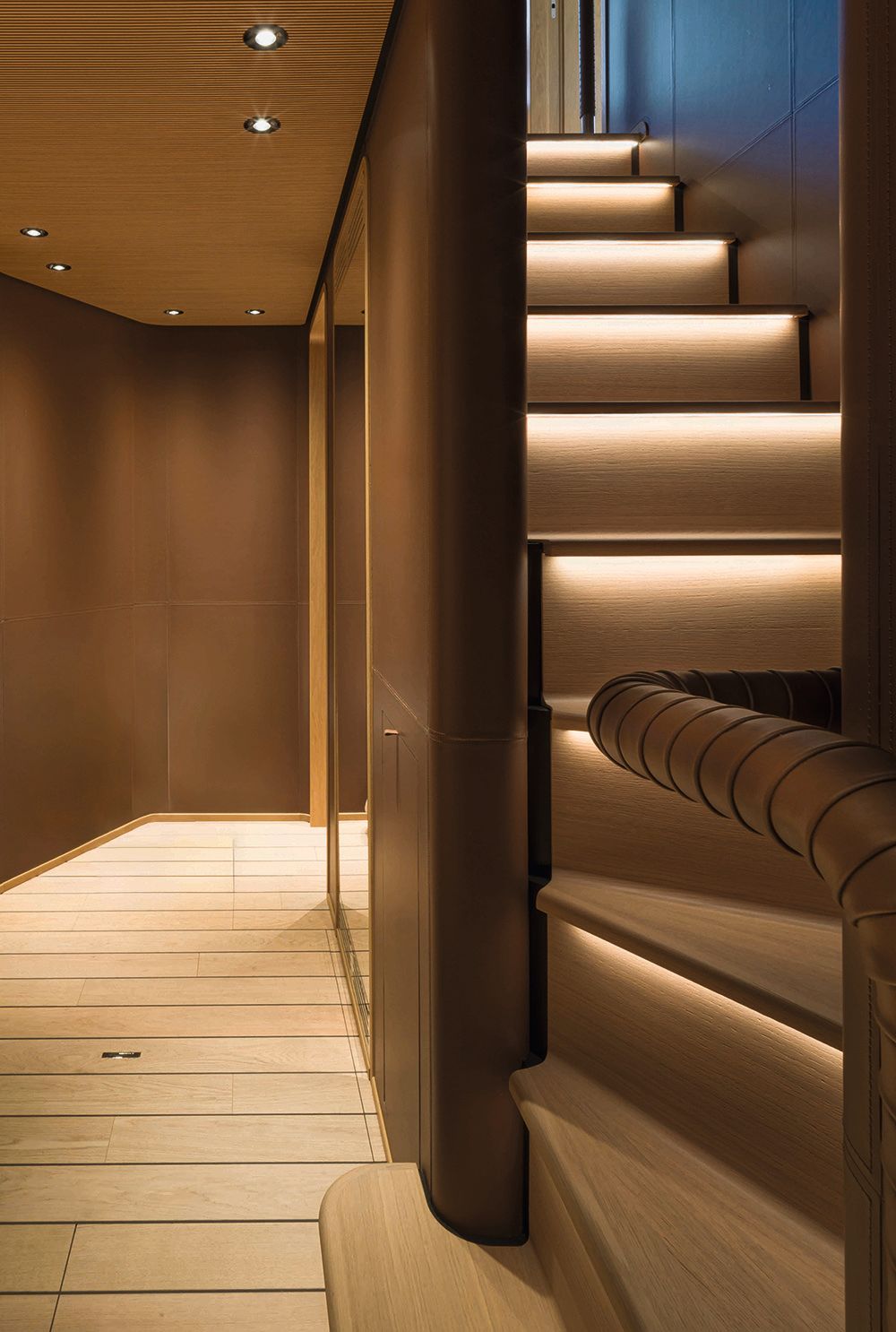
CUSTOM LINE YACHTS
CUSTOM LINE YACHTS
Also related to sensation on board was noise and vibration attenuation, so floating floors and plenty of insulation are the norm throughout. There’s a Heinen & Hopman air con system, which is bigger but quieter; treatments to the lower deck windows to reduce noise from splashing; and foam-cored doors with rubber gaskets that drop down when closed to complete a noise-reducing seal around the frame. This stuff may not be glamorous, but it’s luxury all the same.
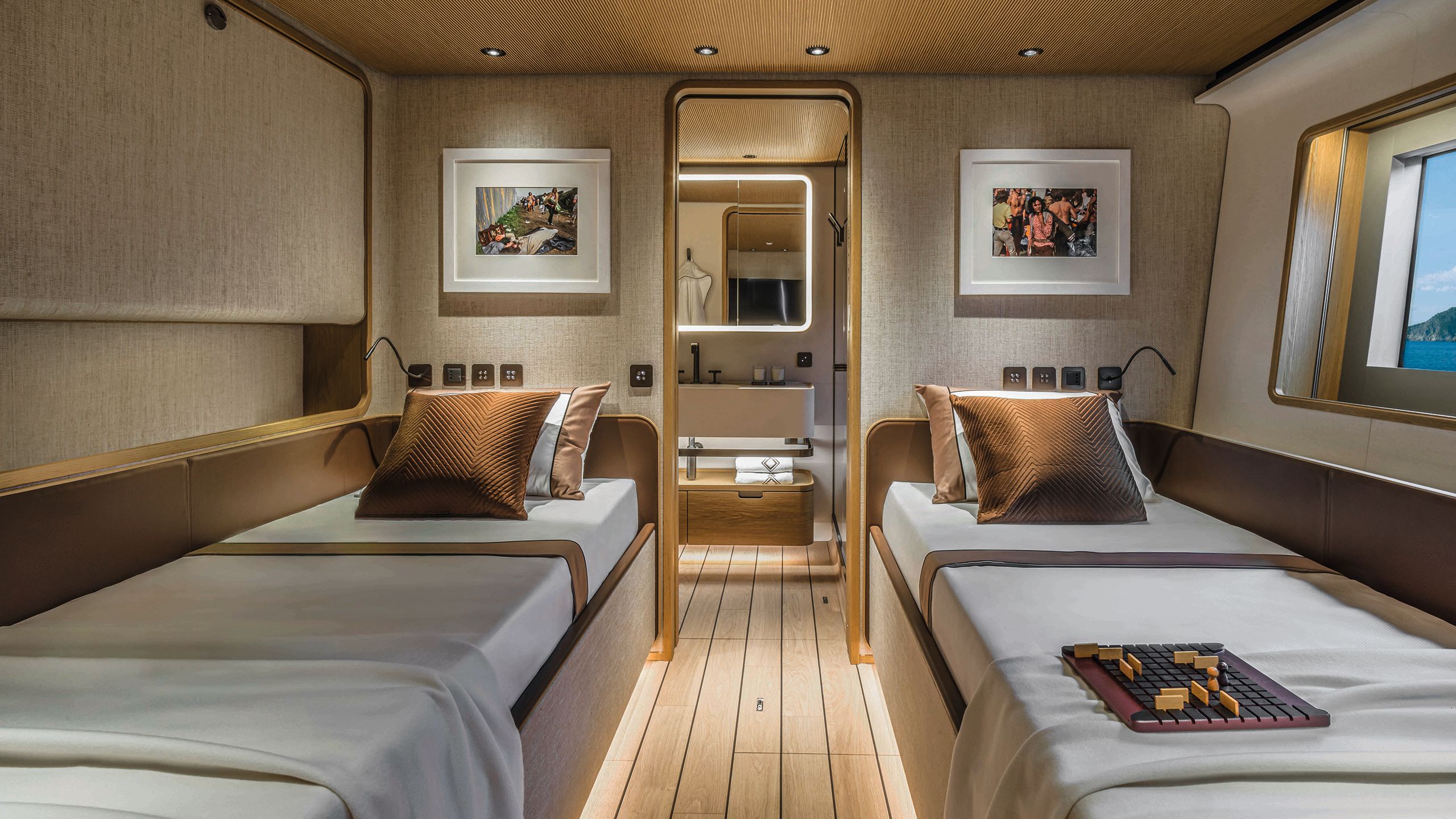
CUSTOM LINE YACHTS
CUSTOM LINE YACHTS
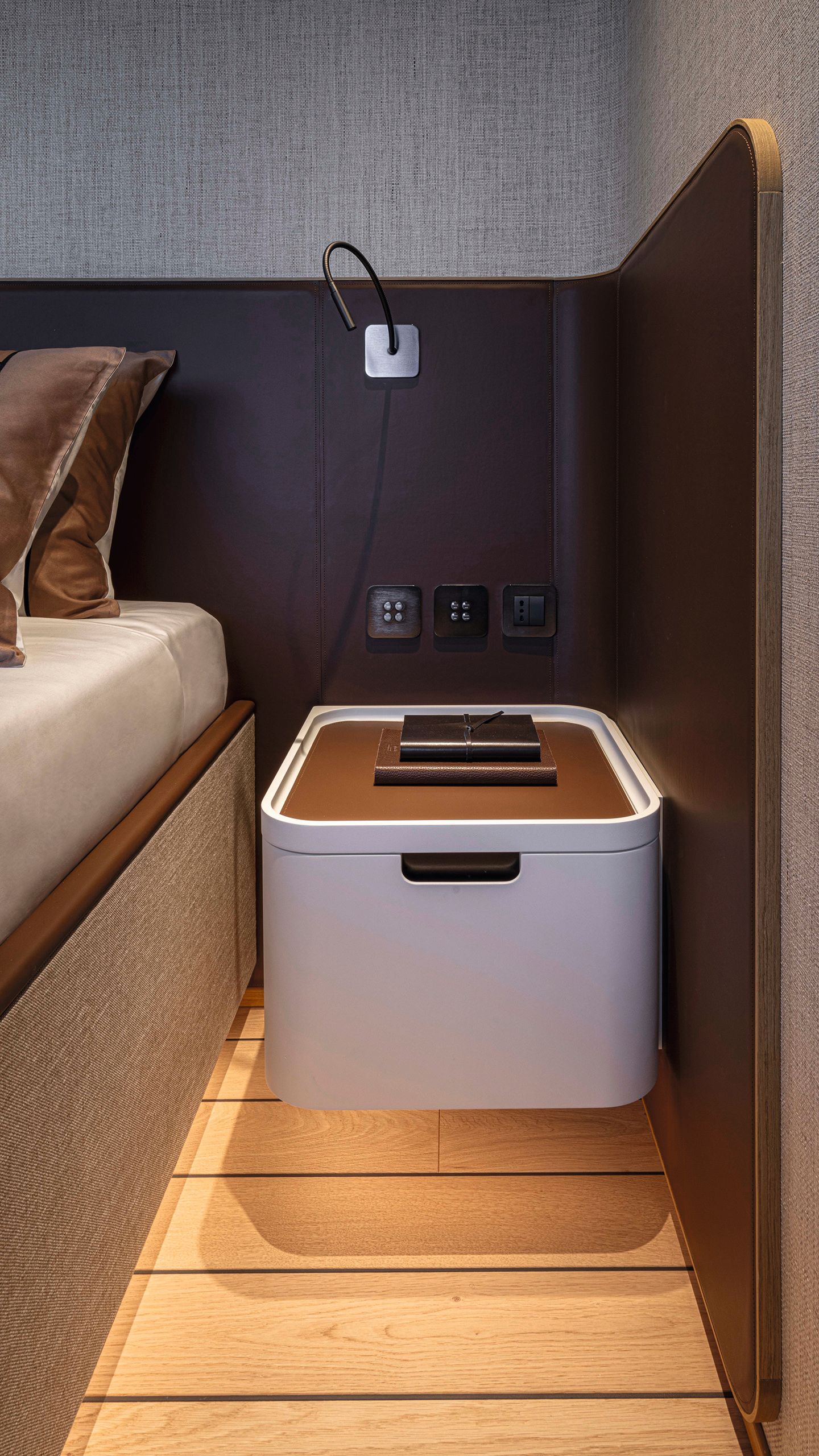
CUSTOM LINE YACHTS
CUSTOM LINE YACHTS
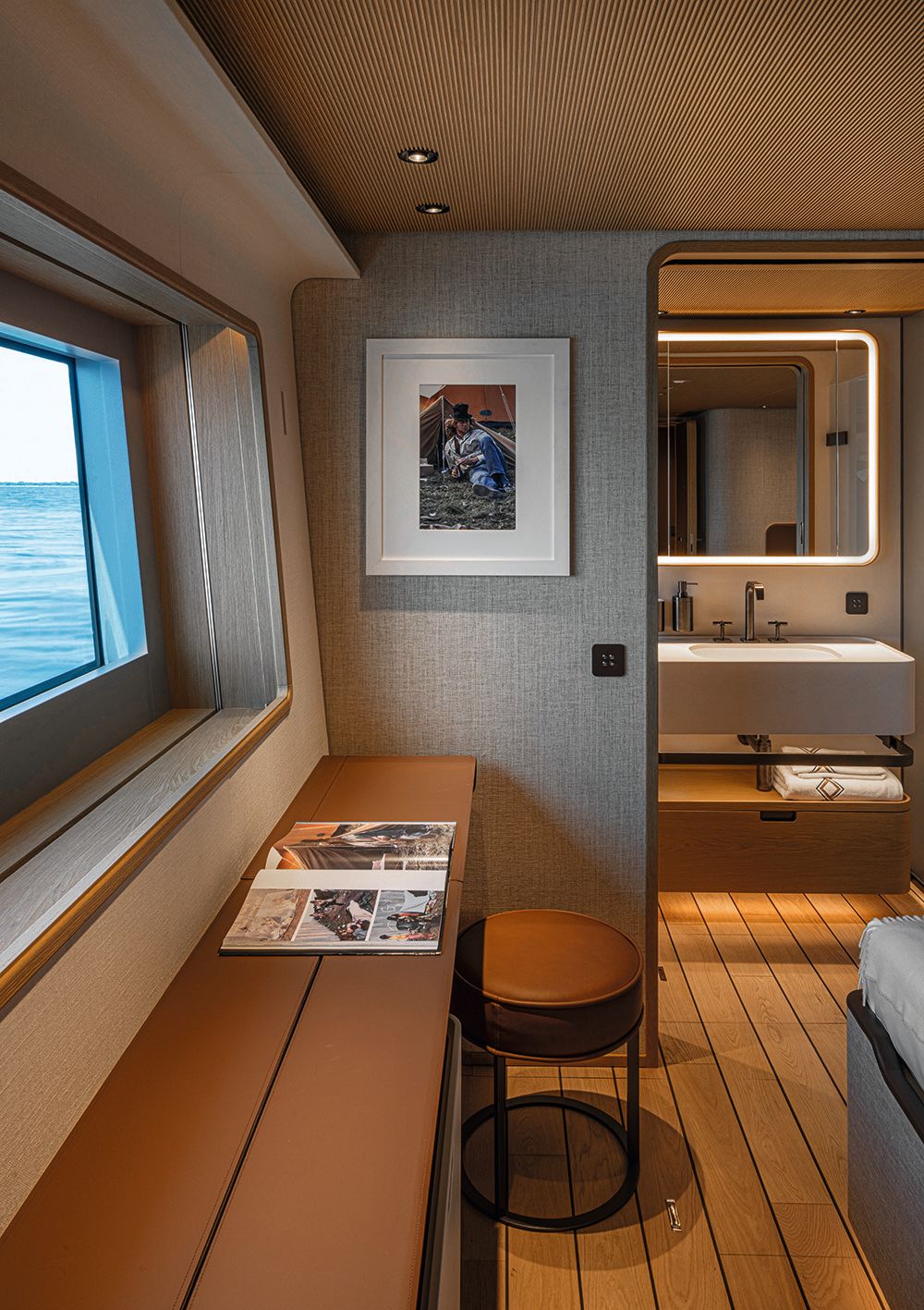
CUSTOM LINE YACHTS
CUSTOM LINE YACHTS
The lower-deck lobby opens to four guest rooms. Three are doubles and one has twin berths, plus a Pullman berth for an extra guest. Raffia wall coverings, oak floors and limestone in the en suites impart the natural feel the interior design team was after
The captain also gets silver service with a pilothouse design that carves out far more space, most notably via twin aisles through the monitors that lead right up to the now-vertical windscreen, for excellent visibility.
The glass also features an ultraviolet filter that reduces heat from radiation by about 65 per cent. The bank of controls is coated with an anti-scratch cellulose and resin coating by Fenix, in a cool matt black.
But perhaps most importantly, how does the real captain of this project feel about the 38? The top line is, unsurprisingly, he loves it.
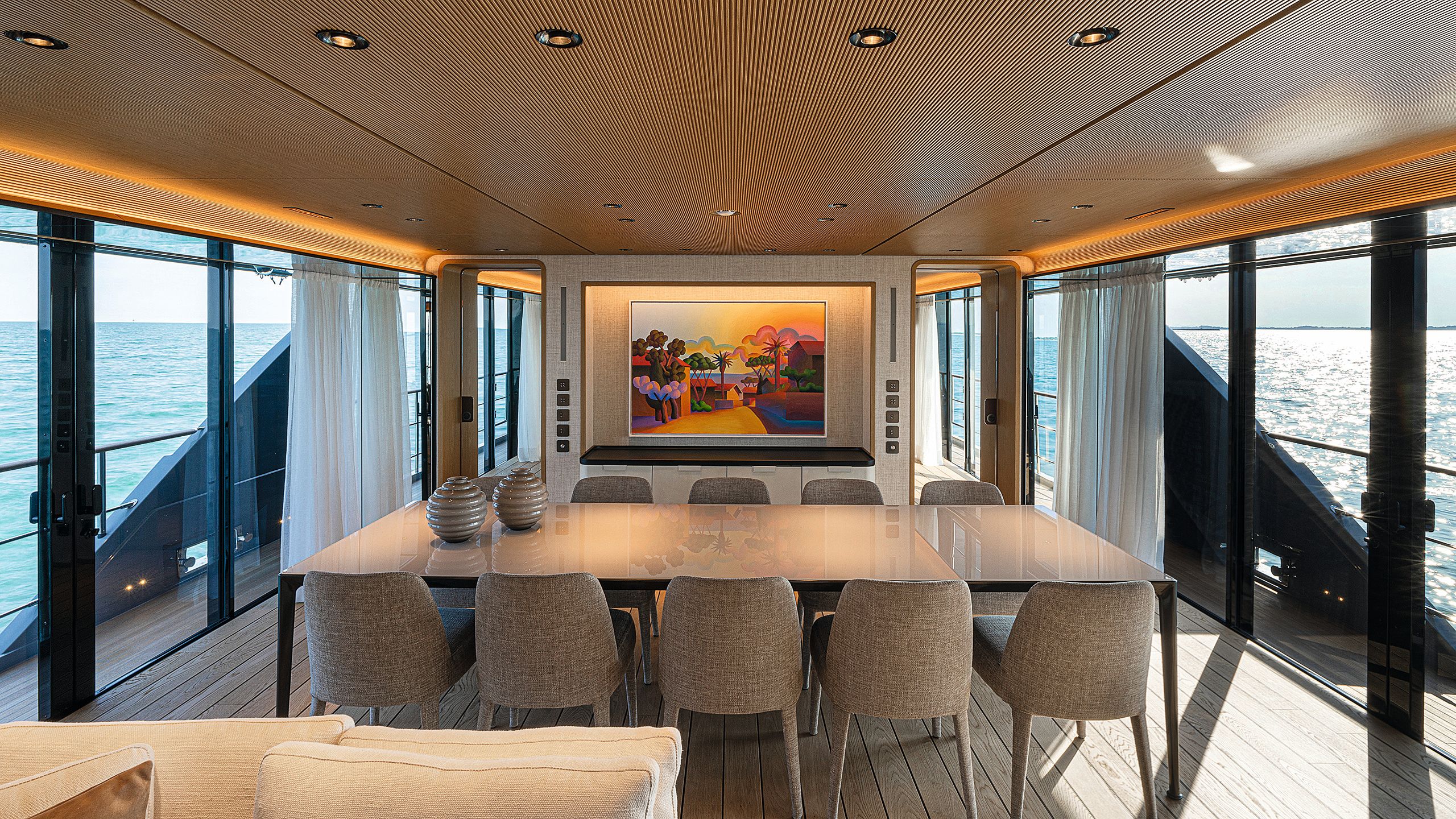

CUSTOM LINE YACHTS
CUSTOM LINE YACHTS
“Elegant, sleek, sexy, charming, low profile. It’s not flashy luxury – it’s understated,” says Galassi. But that doesn’t mean he’s taking it easy on Telli. Custom Line intentionally tested her in bad weather and then set her to work as a demonstrator boat, travelling the world so that a selection of the Group’s top clients can enjoy her.
It appears to be working – eight units had been sold at time of writing. Who knows what those clients will buy later in their yacht-owning career, but the 38 was designed to ensure it’ll be a Ferretti Group boat.
First published in the August 2024 issue of BOAT International. Get this magazine sent straight to your door, or subscribe and never miss an issue.
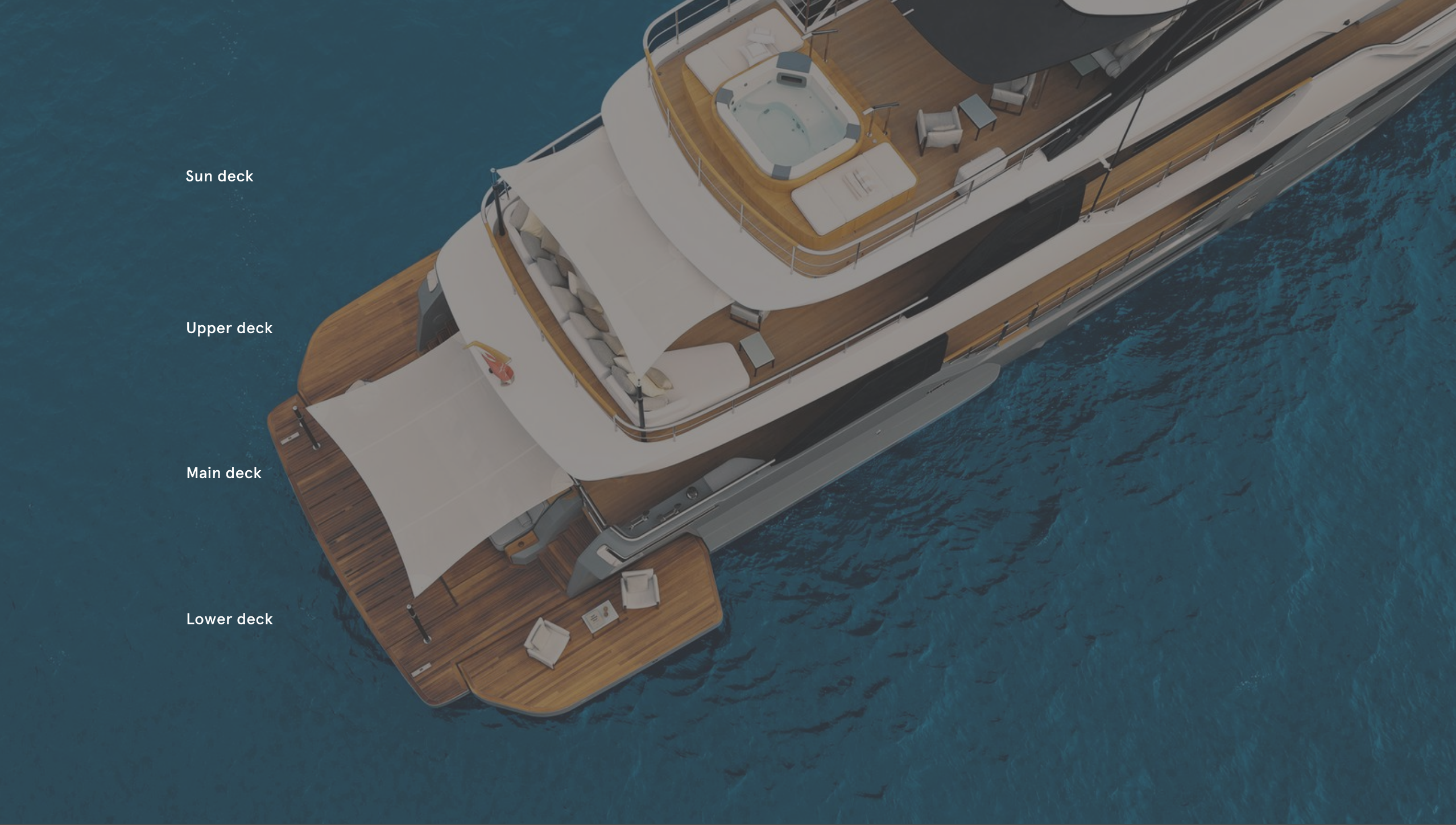
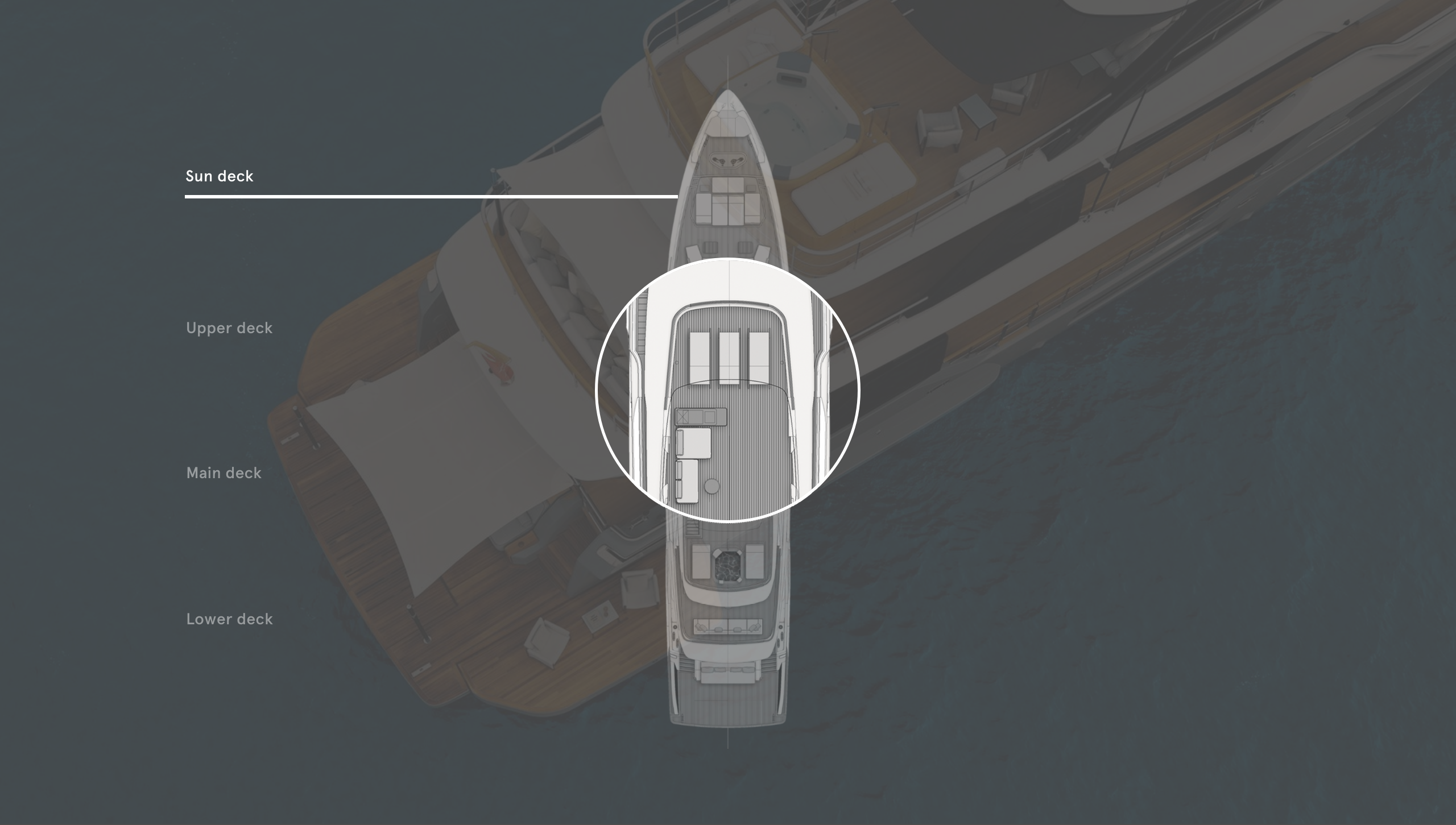
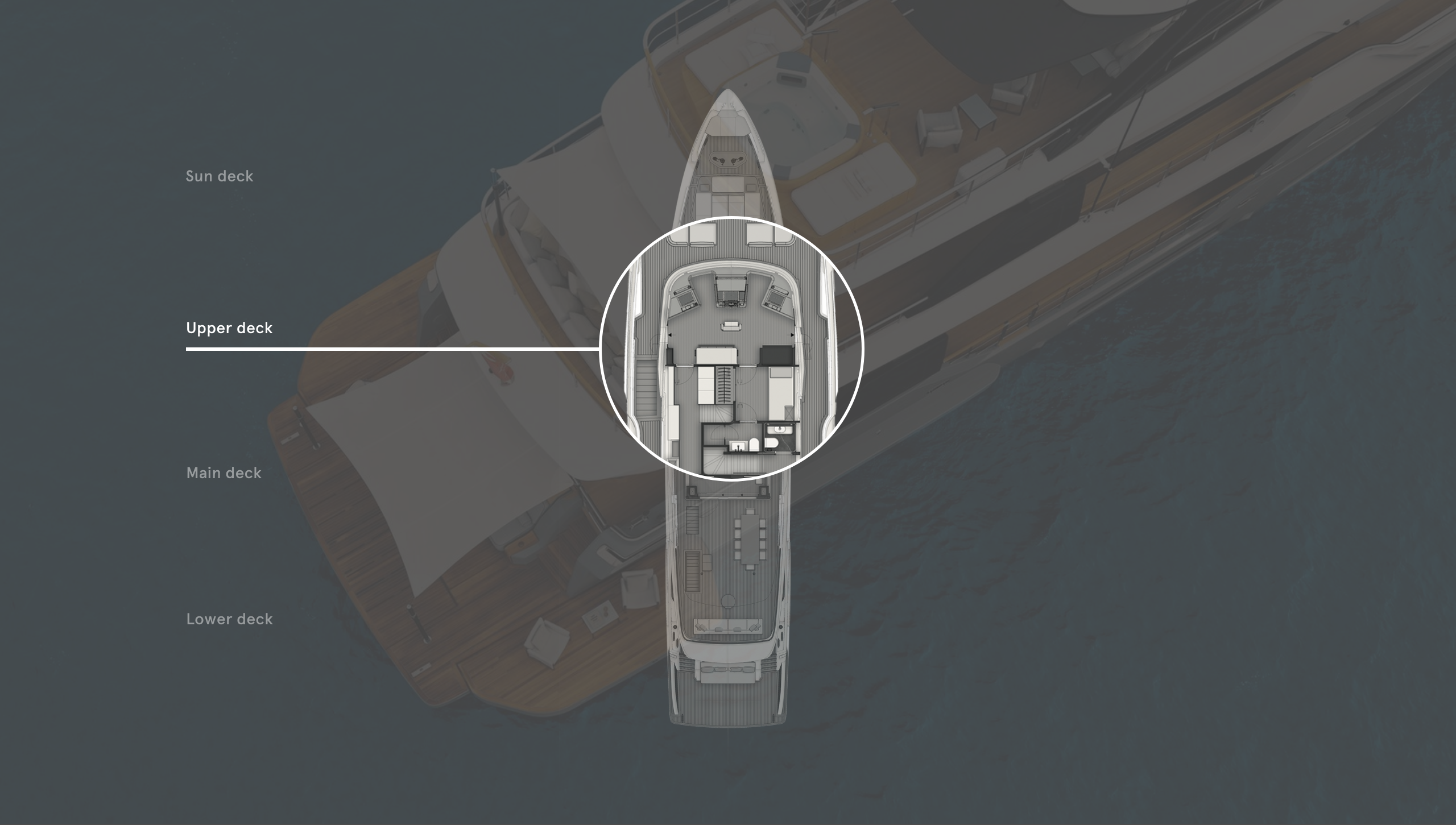
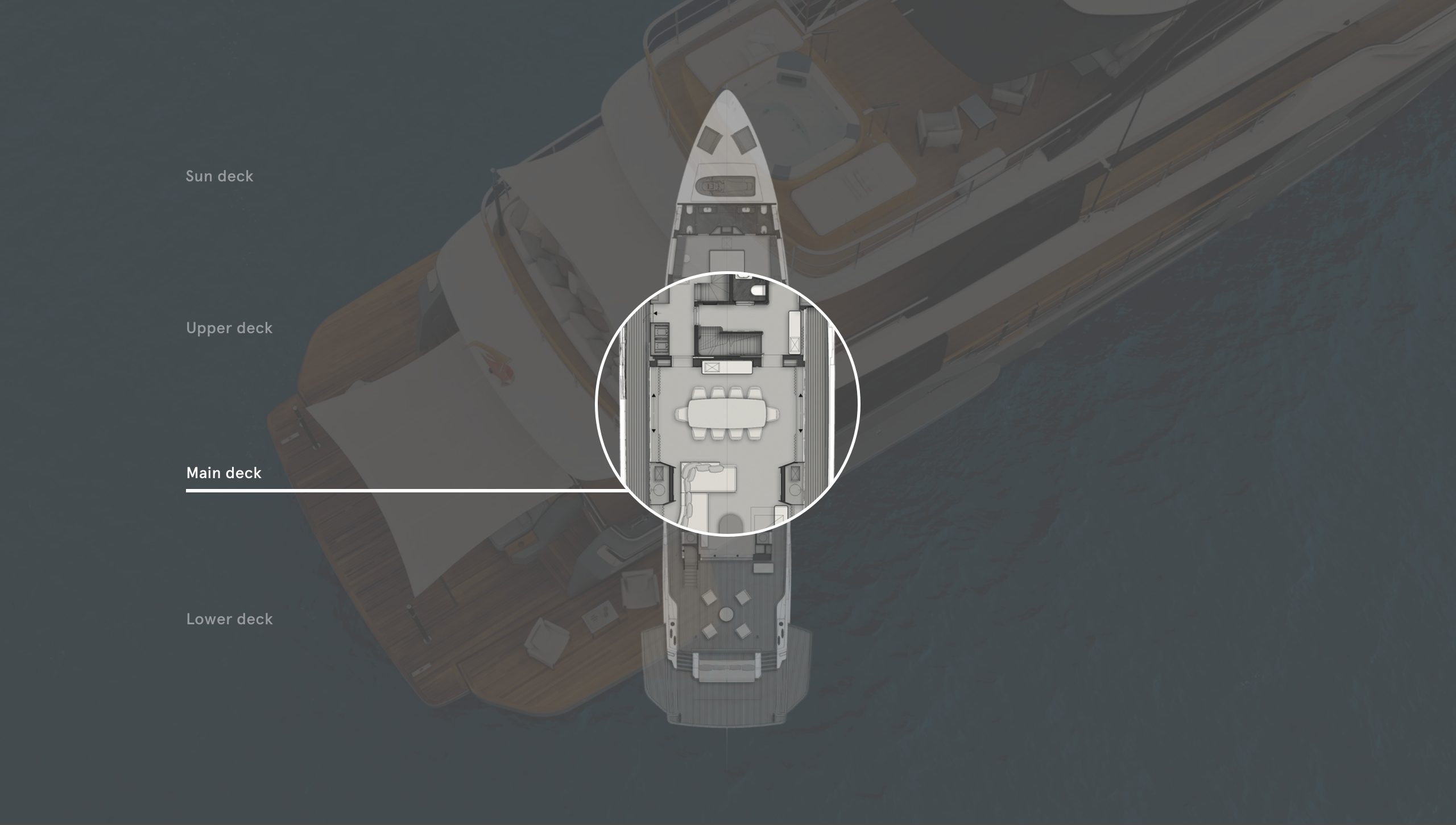
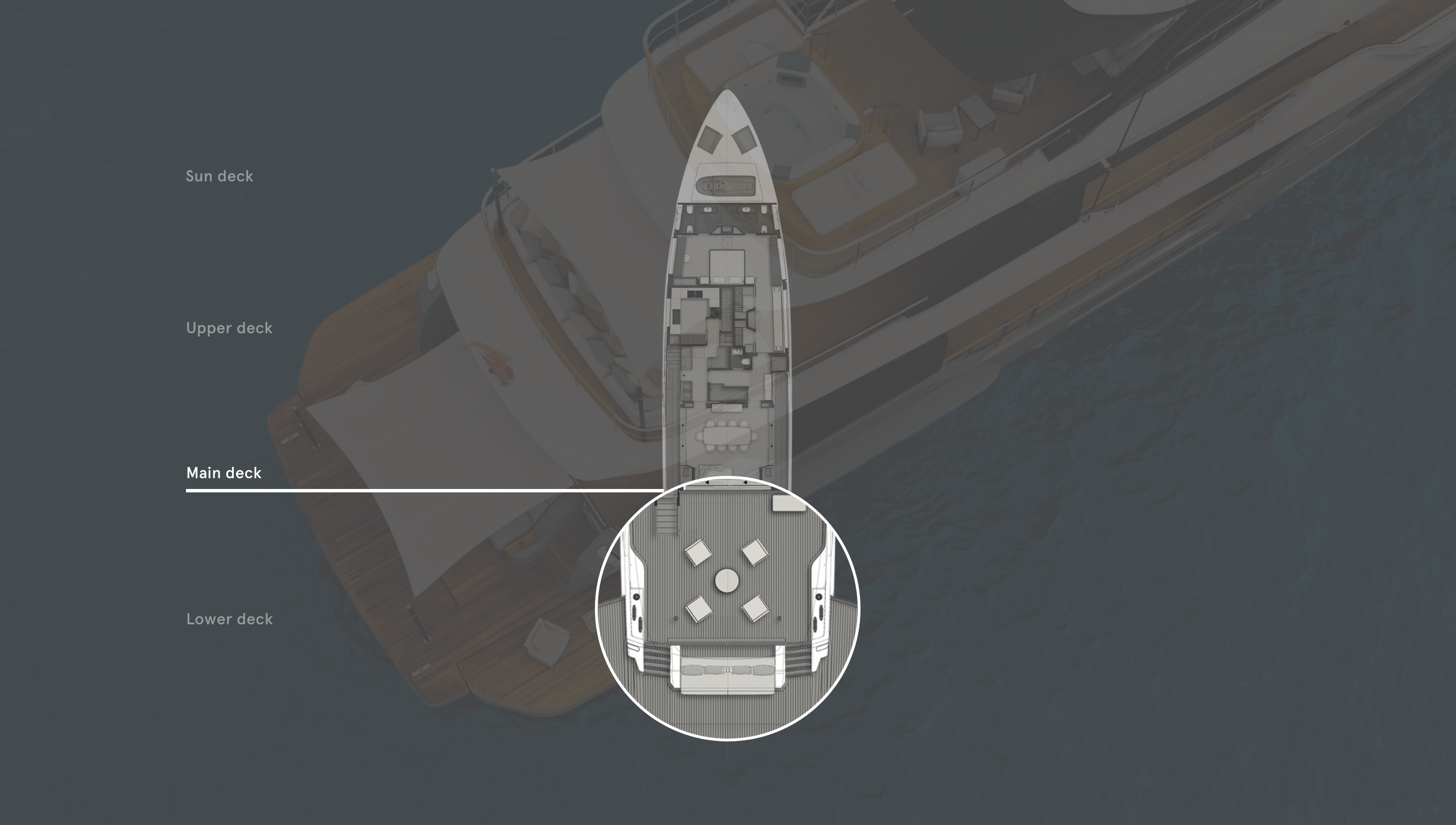

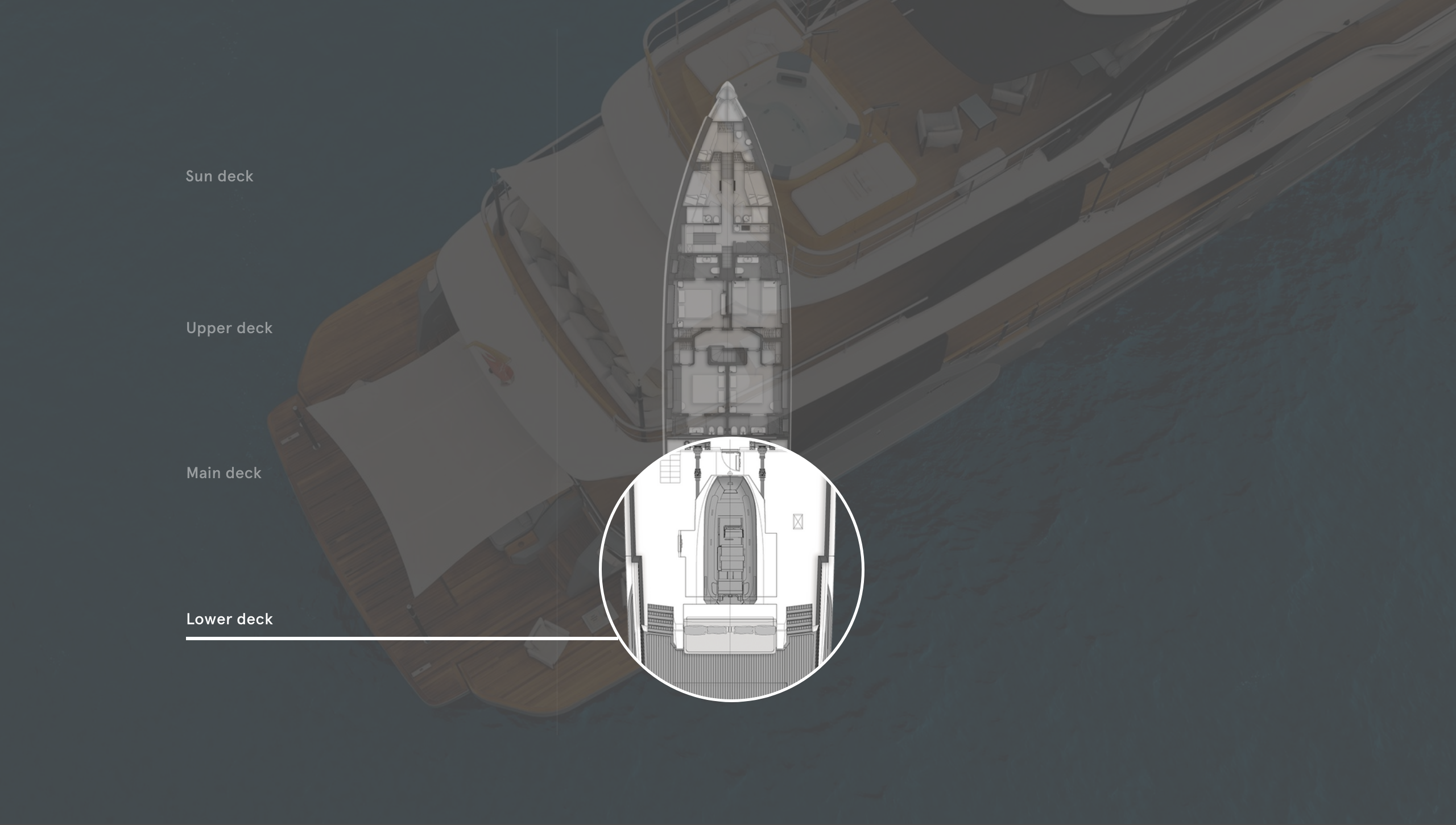

B&B Italia and Maxalto supplied the loose sundeck furniture
The sundeck is 20 per cent larger than on the Navetta 37
Close-up access to the vertical bridge windows makes it easier for watch crew to look out
Sliding doors on either side of the table allow diners to enjoy a cross breeze
The side wings can lower together or asymmetrically
Four guest cabins are equitably sized
The garage fits a tender of 5.65m, which rolls out slipway style
LOA 38.76m | Gross tonnage |
LWL 33.89m | Engines |
Beam 8m | Generators |
Draught 2.27m | Speed (max/cruise) |
Range at 10 knots | Owners/guests 12 |
Fuel capacity | Crew 7 |
Freshwater capacity | Construction |
Tender | Classification |
Naval architecture | Builder/year |
Exterior design | Ancona, Italy |
Interior design | +39 071 5011111 |

